SRAM’s XX T-Type Eagle Transmission is the brand’s all-new range-topping trail and enduro groupset.
SRAM hopes to rewrite the rulebook with its innovative direct-mount derailleur, its design intended to make derailleur hangers and adjustment screws obsolete.
XX T-Type’s all-new approach to drivetrains is designed to make setup and installation easier, quicker and more reliable, increase shifting performance under power and improve strength and reliability with user-replaceable parts.
Arguably, T-Type isn’t the first direct-mount rear derailleur. Shimano’s 2003 Saint groupset, 2005’s Hone and 2012’s direct-mount design were all marketed as such, but each still had a hanger-like element to their design.
T-Type’s truly hangerless approach separates it from Shimano’s early ventures into the direct-mount realm.
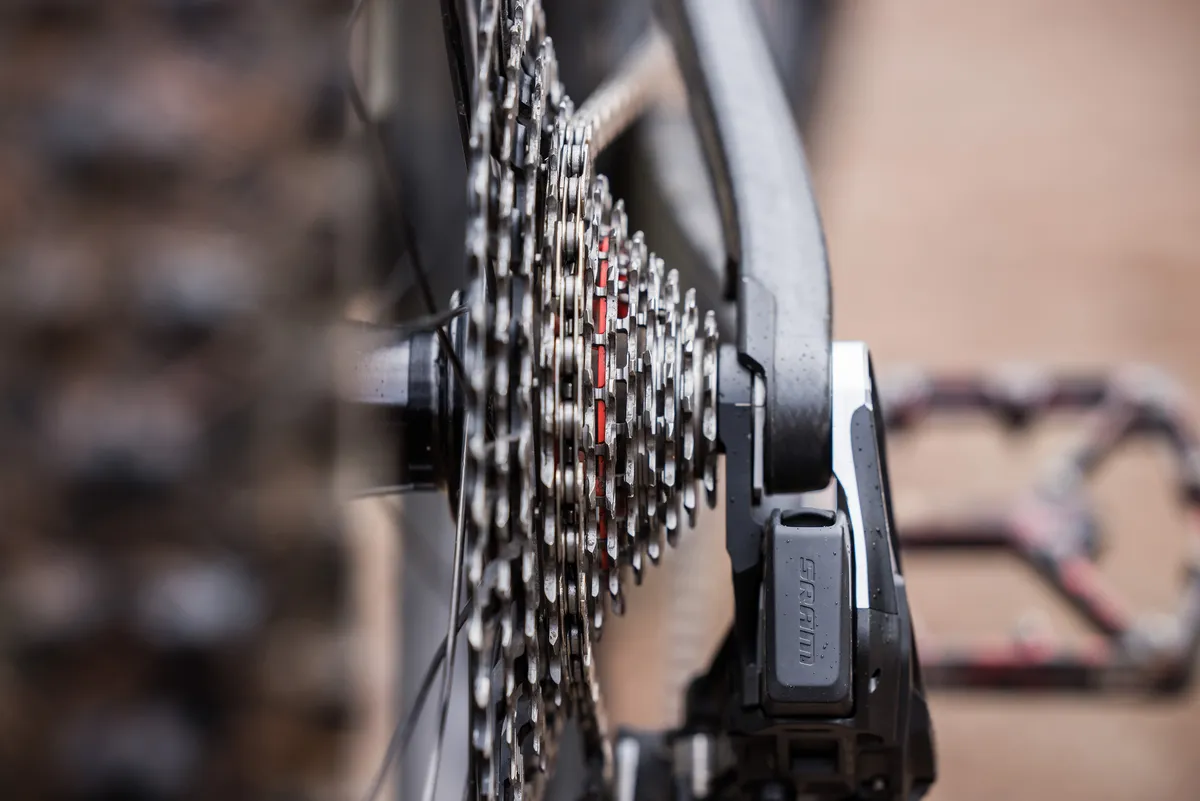
Over the 1,000km test period, T-Type’s performance has proven it to be worthy of SRAM’s bold claims.
SRAM XX T-Type Eagle Transmission Powermeter AXS groupset headline figures
- Total weight (including 170mm DUB-PWR Powermeter cranks with 32t chainring and bash guards, rear derailleur with battery, 126-link chain with Power Lock, 10-52t cassette and Pod Controller Ultimate): 1,785g
- Total price (including 170mm DUB-PWR Powermeter cranks with 32t chainring and bash guards, rear derailleur with battery, 126-link chain with Power Lock, 10-52t cassette and Pod Controller Ultimate): £2,465 / $2,299 / €2,750
On the trail, it redefines the performance traditional derailleur drivetrains are capable of.
On-power shifting, overall robustness, and ease of use and installation are all second to none, and make even this costly XX version worthy of its asking price.
Those looking for top-tier performance, impressive robustness and cutting-edge technology from their mountain bike groupset will love the XX T-Type Eagle Transmission.
SRAM XX T-Type Eagle Transmission Powermeter AXS groupset details and specifications
I’m going to run briefly through the new groupset’s specs below, but if you’d like an in-depth rundown of all its technological innovations, check out my T-Type Eagle Transmission news story.
We also have a guide on how to install and set up the new T-Type Eagle Transmission derailleur.
SRAM XX T-Type Eagle Transmission AXS 12-speed rear derailleur
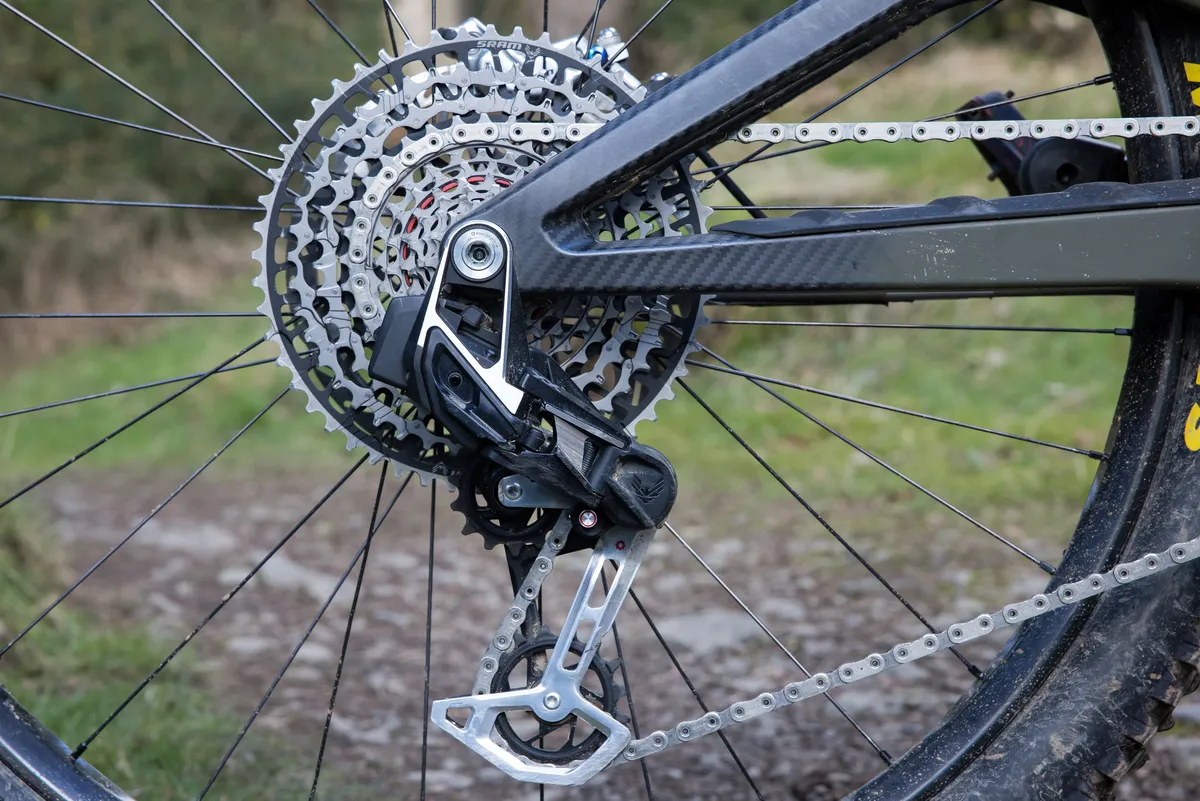
The T-Type derailleur is the star of SRAM’s new drivetrain.
Its innovative mounting design – dubbed Full Mount – removes the need for a derailleur hanger, attaching directly to the gap (called the Hangerless Interface) left by removing SRAM’s Universal Derailleur Hanger (UDH).
This design eradicates b-tension and limit adjustment screws, along with complicated setup procedures involving chain-gap measurement tools.
Conventional derailleurs are mounted to hangers below the cassette’s centre point, frequently with a fore or aft offset, which is the reason for b-tension adjustment.
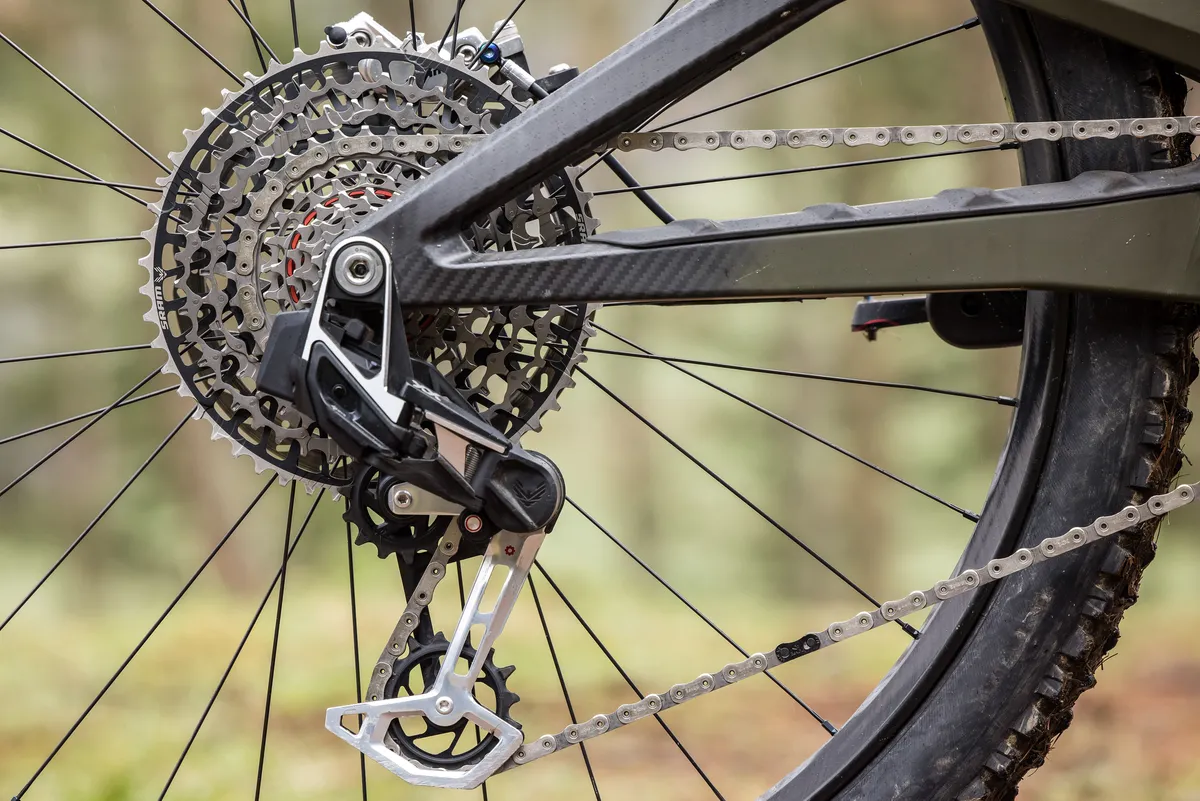
Mounting the derailleur at the rear wheel axle means it has no vertical or horizontal offset. The derailleur’s position relative to the cassette remains constant regardless of gear selected or chain stretch caused by suspension compression.
Eliminating variations in distance between derailleur and cassette caused by hangers means limit screws aren’t needed.
Pre-determined chain lengths and a setup procedure using the Setup Key, along with the Full Mount design, are crucial in removing the need for b-tension.
The derailleur is stacked with features to improve robustness and longevity.
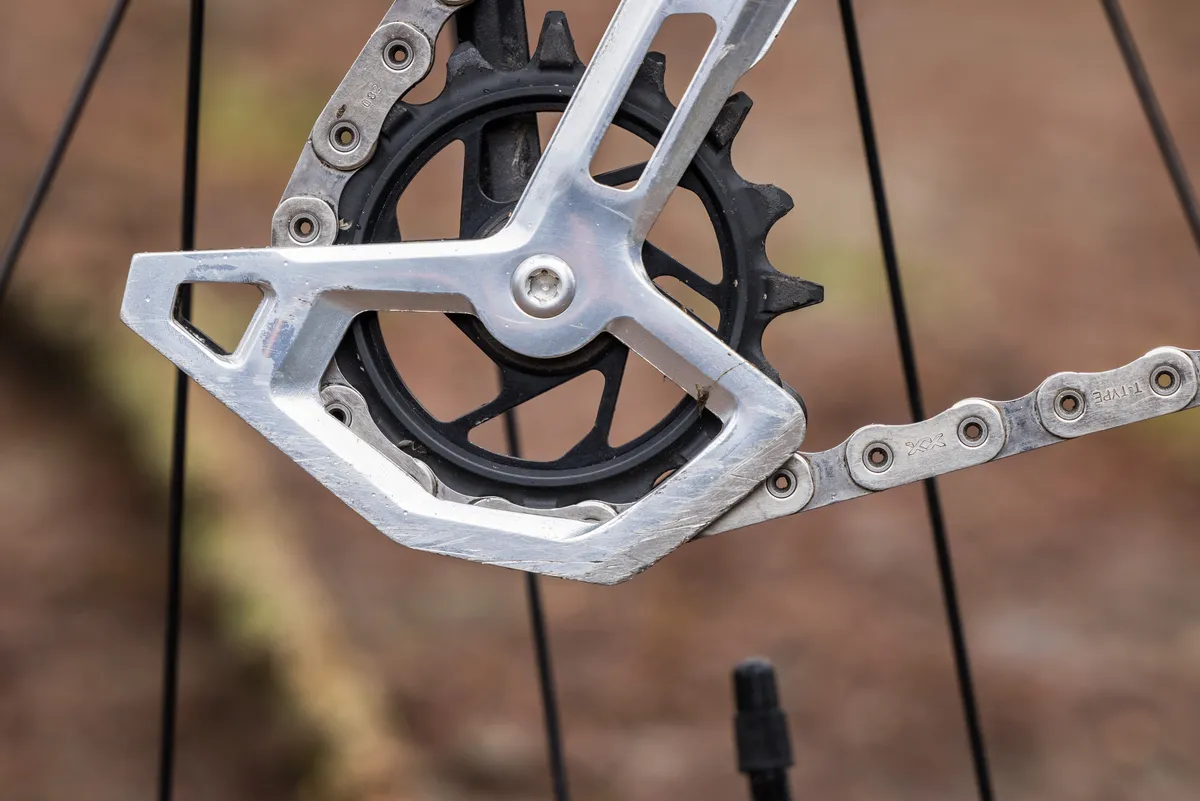
Called Magic Wheel, the XX derailleur’s lower jockey wheel has a wheel-on-wheel design. If its rotation is blocked, the outer portion can continue to turn on the inner section, reducing the chances of a chain jam.
Parts of the derailleur are replaceable. Along with the traditionally replaceable jockey wheels, other parts can also be swapped out.
The outer parallelogram links and its Skid Plate (that sits on the b-knuckle) can be changed with Allen keys.
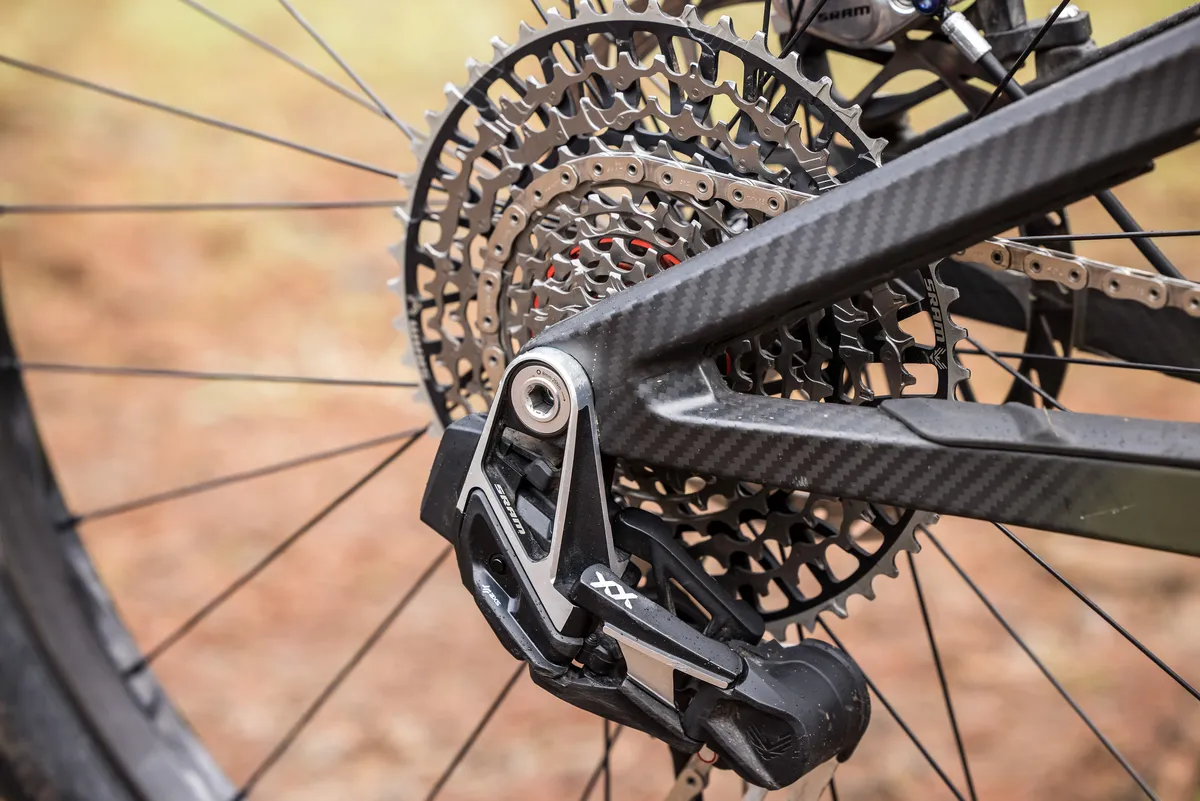
Removing the cage is a tool-free procedure. It simply unscrews from the derailleur’s p-knuckle, taking the clutch mechanism with it.
AXS’s Overload Clutch disengages the derailleur’s motor and gearbox in a hard impact, enabling it to move out of the way and reducing the potential for damage. Post-impact, the derailleur shifts back to its original position.
Replacing the function of the inboard and outboard limit screws are stopper plates. To stop inboard movement, the plate contacts the cassette’s largest sprocket before it can enter the wheel’s spokes. There’s also a stopper to prevent it from moving outboard too far.
SRAM claims the new T-Type derailleur is its best-shifting yet, stating shift quality improves under load.
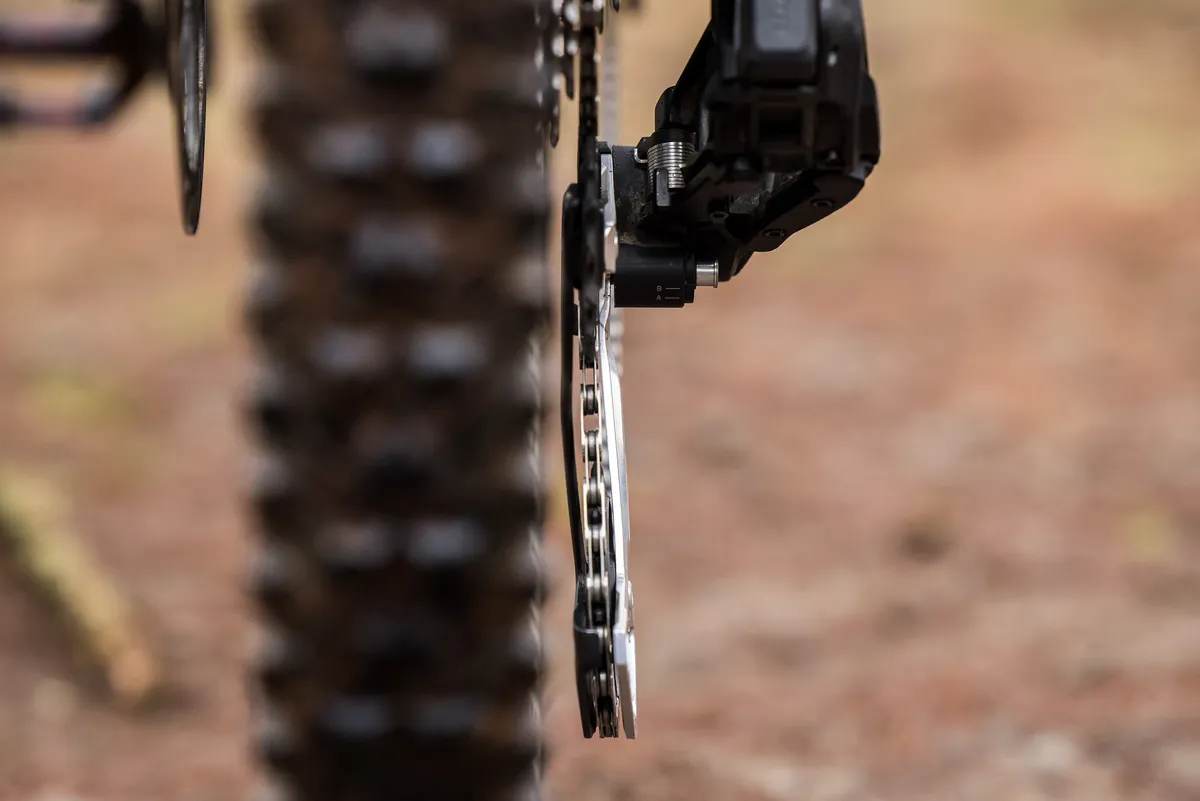
Cassette Mapping shift firmware – where the derailleur’s shifts are timed to match the shift lanes on the cassette – prevents the derailleur from shifting when it shouldn’t.
This means on-power shifts should be smooth and controlled. SRAM says the XX derailleur can withstand shifting under “1,000-watt [power] surges” on electric mountain bikes.
Its cage – instead of the b- or p-knuckles on other derailleur designs – is angled or canted towards the chainring, looking ‘bent’ if observed from the rear, and is called the Inline Cage because it lines up with the chainring.
This is claimed to improve shifting performance and reduce chain wear.
SRAM XX T-Type Eagle Transmission AXS Pod Ultimate Controller
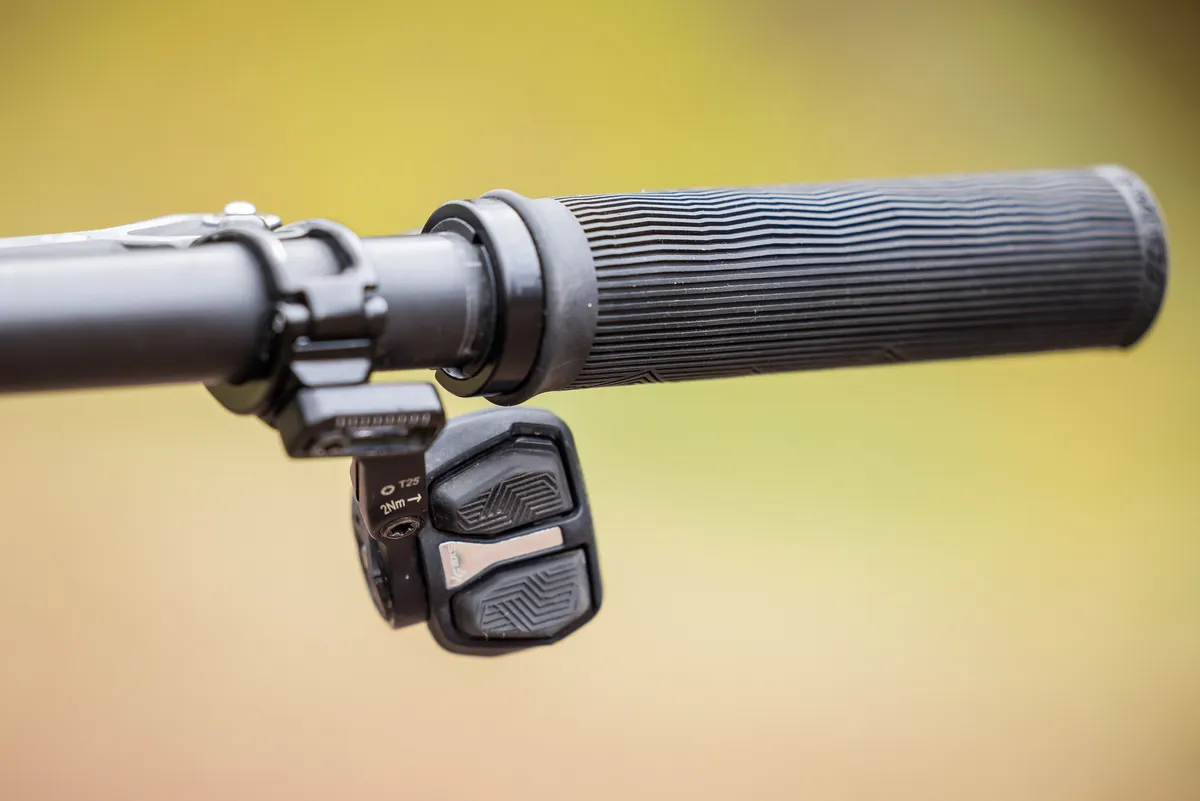
Second to the derailleur’s striking design is the all-new T-Type AXS Pod Controllers, now with two vertical, in-line buttons.
Ultimate Pod Controllers have user-replaceable concave and convex buttons.
Pod Controllers are modular, too. The electronic and mechanical sections can be separated, which could expand their functionality and means they’re repairable.
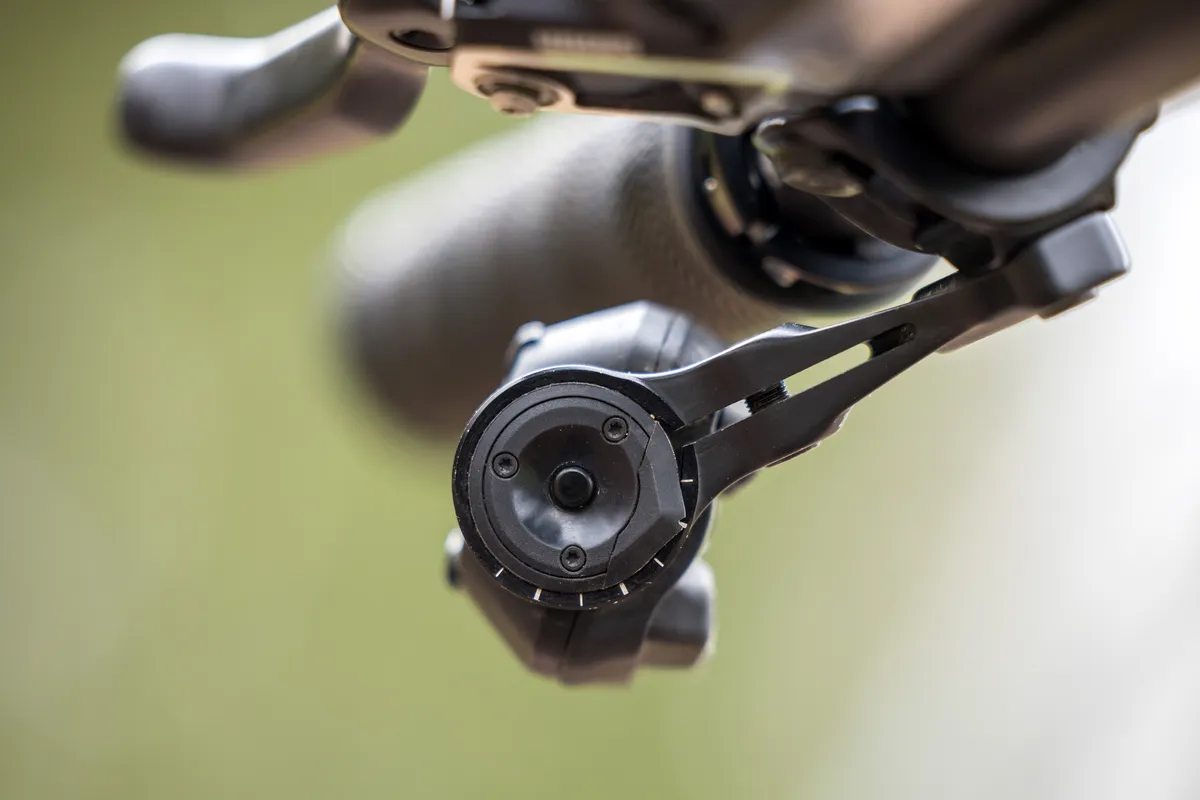
Their flippable design means they can be used on the left-hand or right-hand side of the bar.
There are two mounting options. The brake lever direct-mount Bridge Clamp replaces Matchmaker X, and there’s a dedicated bar mount called Infinity Clamp.
Cassette and chain

T-Type cassettes use SRAM X-Sync’s narrow-wide tooth profile that integrates with the derailleur’s cassette mapping to improve shifts.
Along with the tooth profiling, the cassette has specific shift ramps or gates that work with the derailleur’s cassette mapping. The chain can only move to the next gear at a ramp, and is blocked when there isn’t one.
This is claimed to vastly reduce miss-shifts.
The T-Type cassette is 2.5mm outboard, compared to Eagle drivetrain cassettes, designed for 55mm chain lines. This repositioning makes the angle between the cassette and chainring in any gear less extreme.
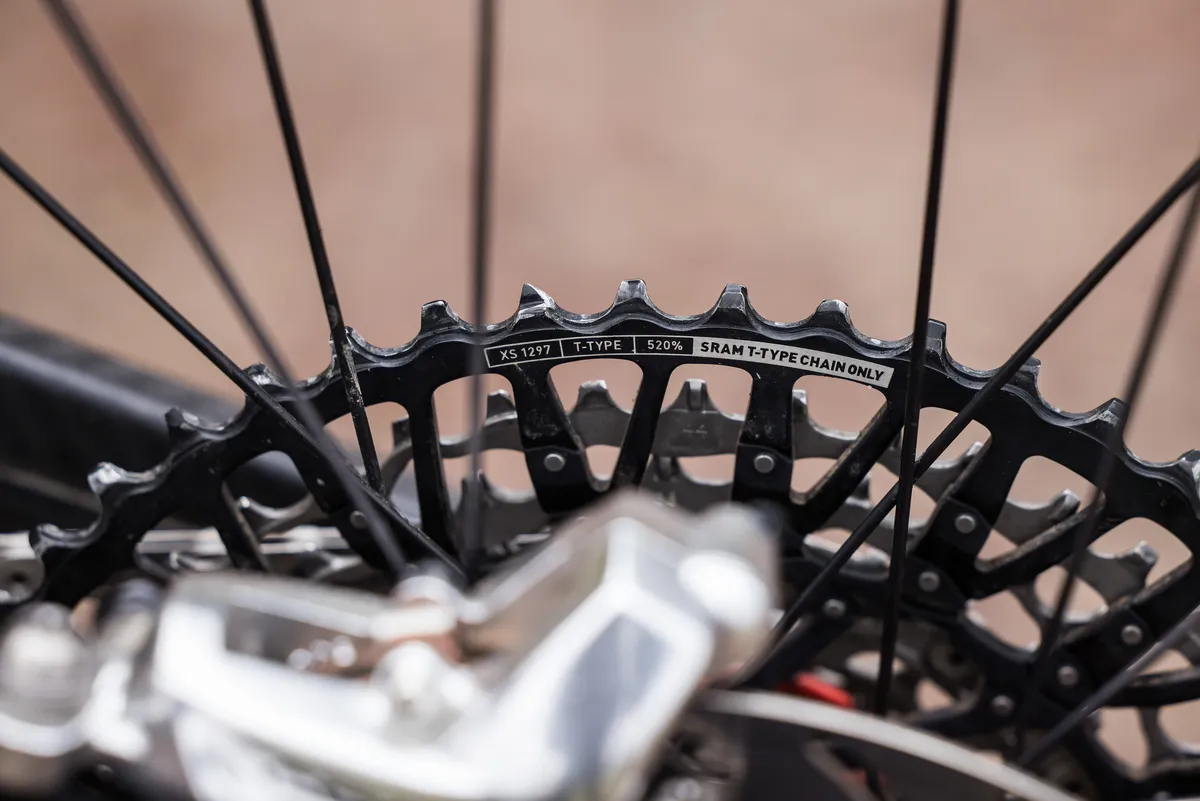
The cassette's ratios have been updated.
The second and third biggest sprockets are 44t and 38t, up from 42t and 36t on Eagle drivetrain cassettes. SRAM hopes the jump to the 52t Eagle sprocket is now less pronounced.
Overall, the cassette’s 520 per cent range remains. Its sprocket sizes are 10, 12, 14, 16, 18, 21, 24, 28, 32, 38, 44 and 52.
The XX cassette has an aluminium 52t sprocket, while its 36t and 42t are made from stamped steel, and the remaining 10-32t are machined steel, using SRAM’s X-Dome design.
XX’s flattop chain is claimed to be the “strongest SRAM chain ever” and is rated for electric bike use. It has hollow pins to save weight and a hard chrome finish to improve its lifespan, and uses specific flattop Powerlocks.
Crankset
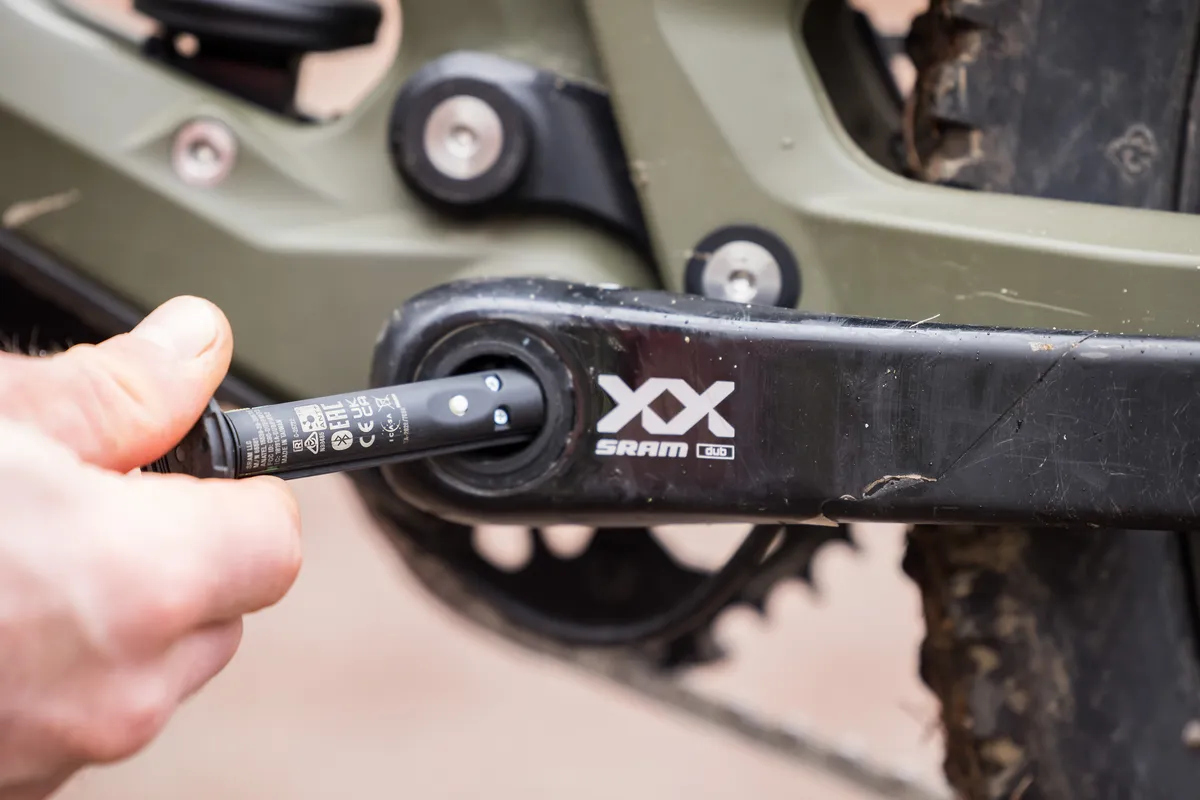
T-Type’s XX crankset, designed for trail and enduro riding, is built from carbon fibre with a foam core to add strength.
It uses an eight-bolt chainring mounting pattern, which means it can be fitted with SRAM’s threaded chainring power meter.
The XX cranks I’ve tested have a DUB-PWR power meter within the crank’s bottom bracket spindle. The power meter is claimed to be +/- 3 per cent accurate, but only measures left-sided power to calculate total watts.
It uses lithium AAA batteries with a claimed 400-hour life. It connects via Bluetooth to SRAM’s AXS smartphone app (for installation, setup and pre-ride zeroing), and is compatible with bike computers such as Garmin’s Edge 830. It has an IPX7 waterproof rating.
XX chainrings are fitted with a two-position, removable bash guard. They use SRAM’s X-Sync narrow-wide tooth profile to improve chain retention.
SRAM XX T-Type Eagle Transmission Powermeter AXS groupset compatibility details
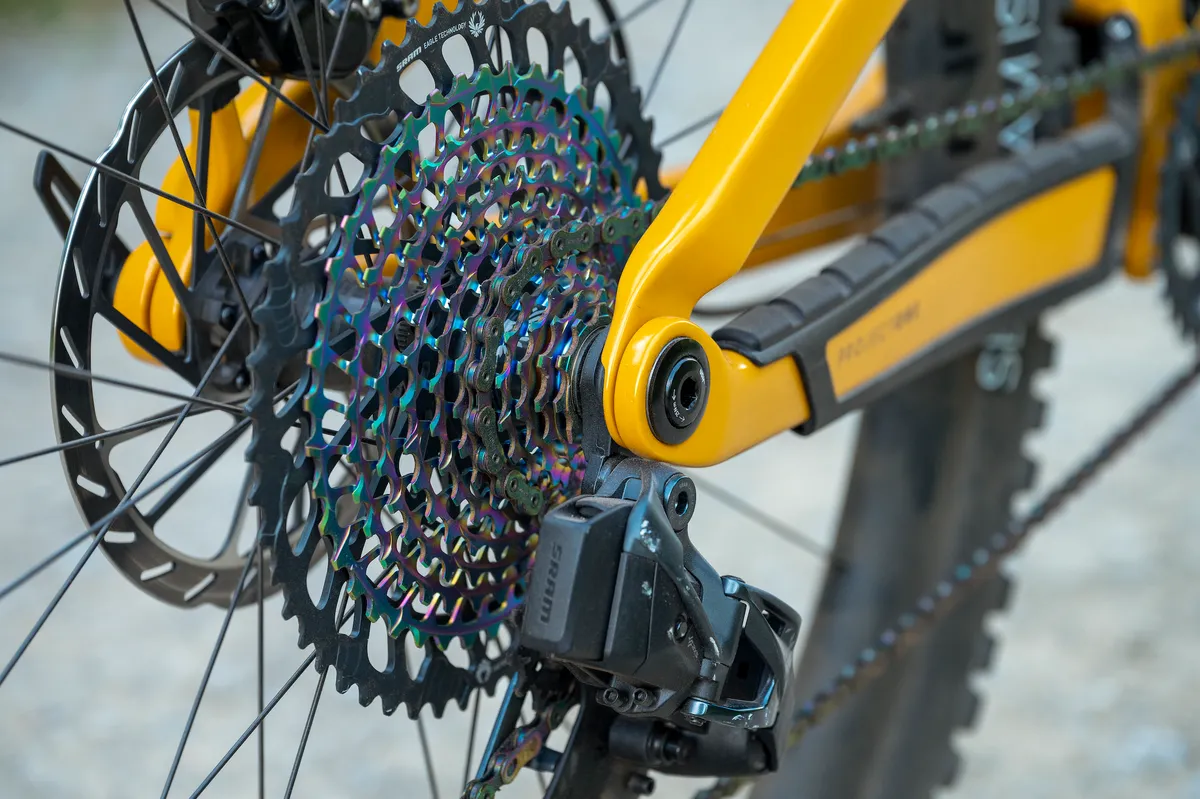
Components in SRAM’s T-Type Eagle Transmission aren’t compatible with Eagle drivetrain or third-party components.
There are two exceptions to this. T-Type AXS Pod Controllers and AXS Controllers will work with any other AXS components, such as derailleurs and seatposts. Also, T-Type chainrings are compatible with Eagle drivetrain chains, but the reverse isn’t true.
Non-eMTB T-Type chainrings use an eight-bolt mounting pattern, which is different from Eagle drivetrain models. This means T-Type chainrings aren’t compatible with Eagle drivetrain cranks and vice-versa.
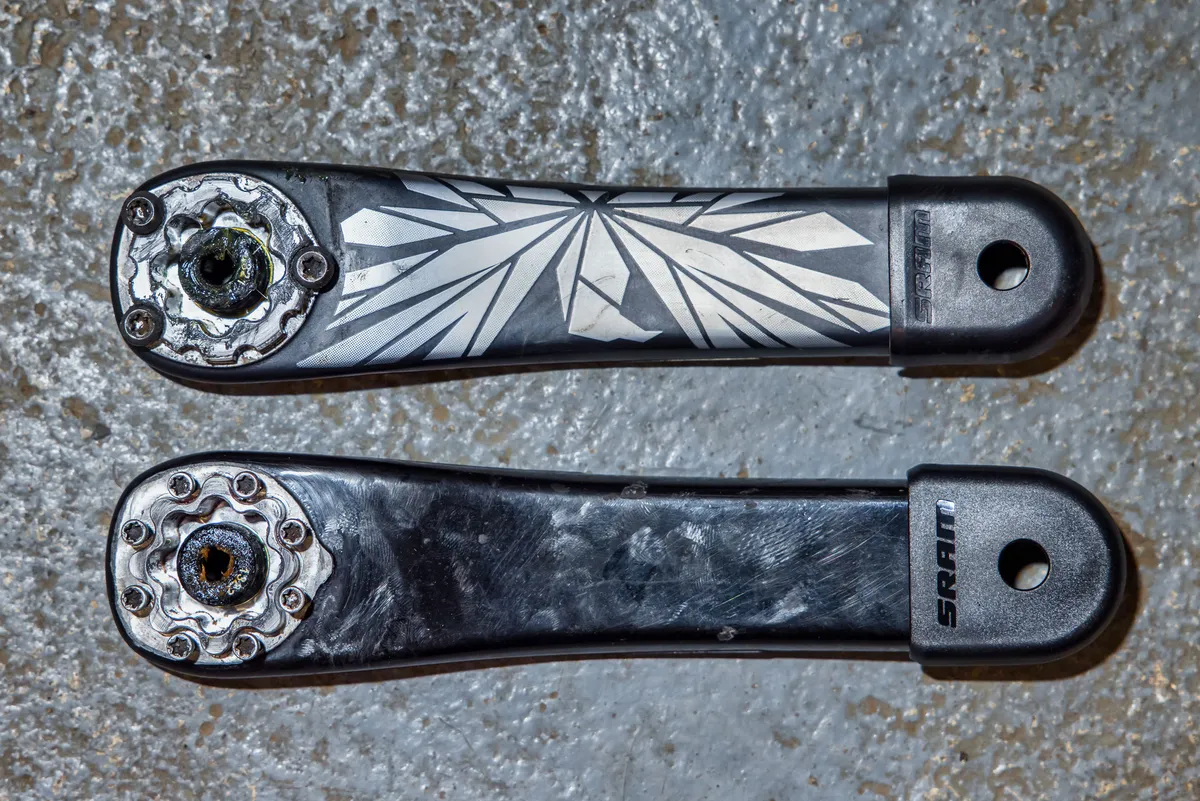
All components within the T-Type ecosystem work together; mixing XX SL, XX and X0 parts is possible.
To upgrade to a T-Type Eagle Transmission, you will need to buy the derailleur, cassette, chain, chainring and pedal cranks, assuming you already own an AXS drivetrain with an AXS Controller. If you don’t, you will also need to add an AXS Pod Controller to the list.
T-Type drivetrains are only compatible with UDH bikes.
The T-Type cassette uses SRAM’s XD Driver standard, which is the same as Eagle drivetrains. Likewise, the cranks are SRAM DUB bottom-bracket compatible
SRAM XX T-Type Eagle Transmission Powermeter AXS groupset weights
The XX T-Type Eagle Transmission Powermeter AXS groupset weighs 1,785g.
| Component | Weight (g) |
|---|---|
| XX T-Type Eagle Transmission derailleur | 472 |
| T-Type Eagle Transmission AXS Pod Controller Ultimate (with Bridge Clamp) | 55 |
| XX T-Type Eagle Transmission cassette | 384 |
| XX T-Type Eagle Transmission 126-link chain with Power Lock | 274 |
| XX T-Type Eagle Transmission 32t chainring with bash guards | 129 |
| XX T-Type Eagle Transmission 170mm cranks with DUB-PWR powermeter | 471 |
| Total weight: | 1,785 |
SRAM XX T-Type Eagle Transmission Powermeter AXS groupset installation and setup
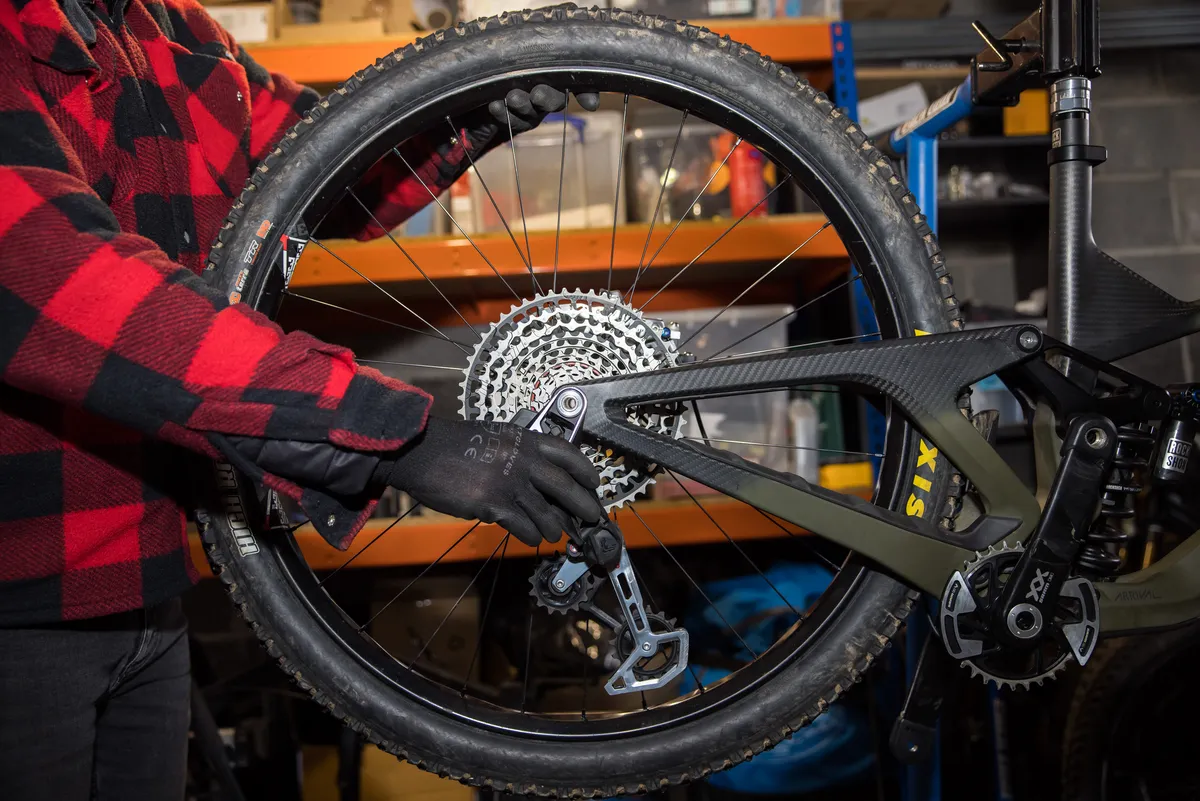
Installing and setting up SRAM’s T-Type Eagle Transmission is different from drivetrains made by SRAM, Shimano and other brands that precede it.
SRAM’s installation instructions are in-depth and appear complicated at first glance. In reality, installation and setup is easy; steps involving at-sag chain gap measurement, limit screw adjustment and on-bike chain measurement have been eliminated.
These are replaced with pre-installation procedures such as Setup Key position, chain length determination using the AXS app, and positioning the chain on the correct cassette sprocket.
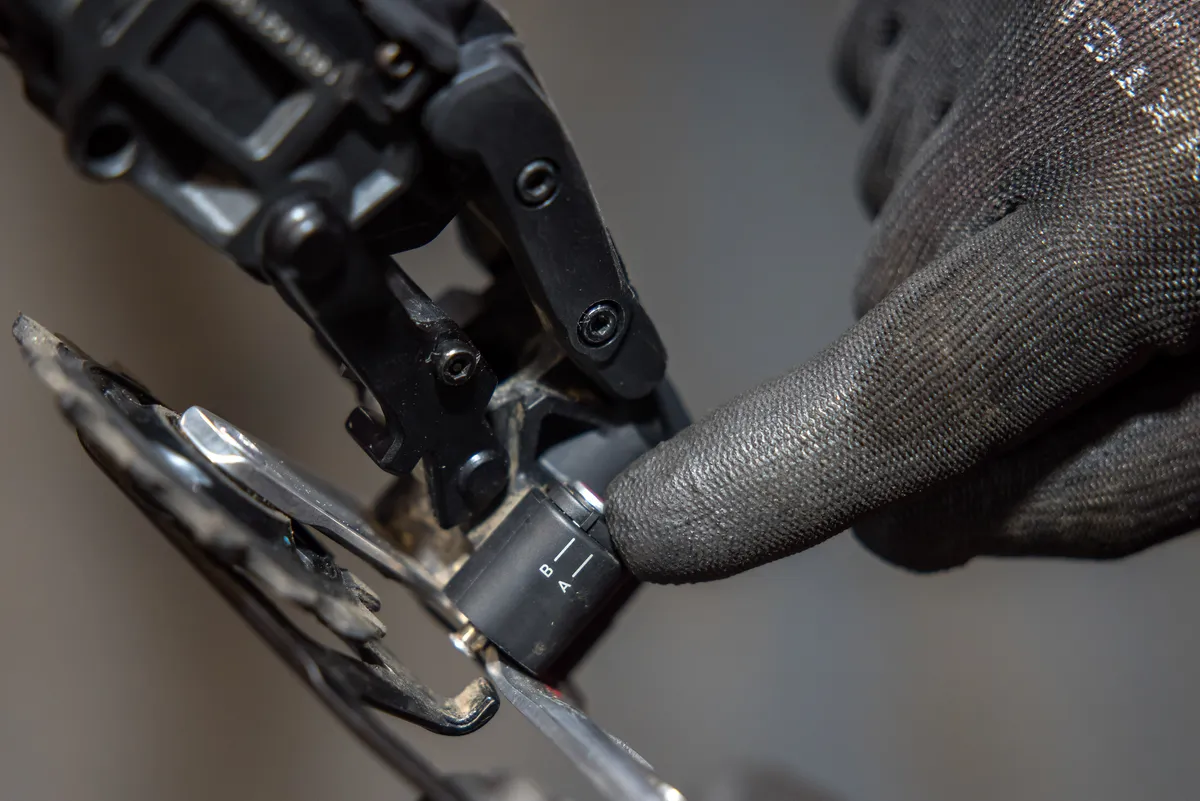
SRAM’s instructions cater for every bike and suspension type, with clear, simple methods for T-Type Transmission installation.
Importantly, if you make changes to your bike’s chainstay geometry adjustment, chainring size or lower idler pulley position, you will need to redo the setup procedure.
Although T-Type has no limit or b-tension adjustment, Micro Adjust is still present. Using the Micro Adjust function trims the derailleur’s position inboard or outboard in relation to the cassette by 0.2mm at a time. There are 14 positions of adjustment.
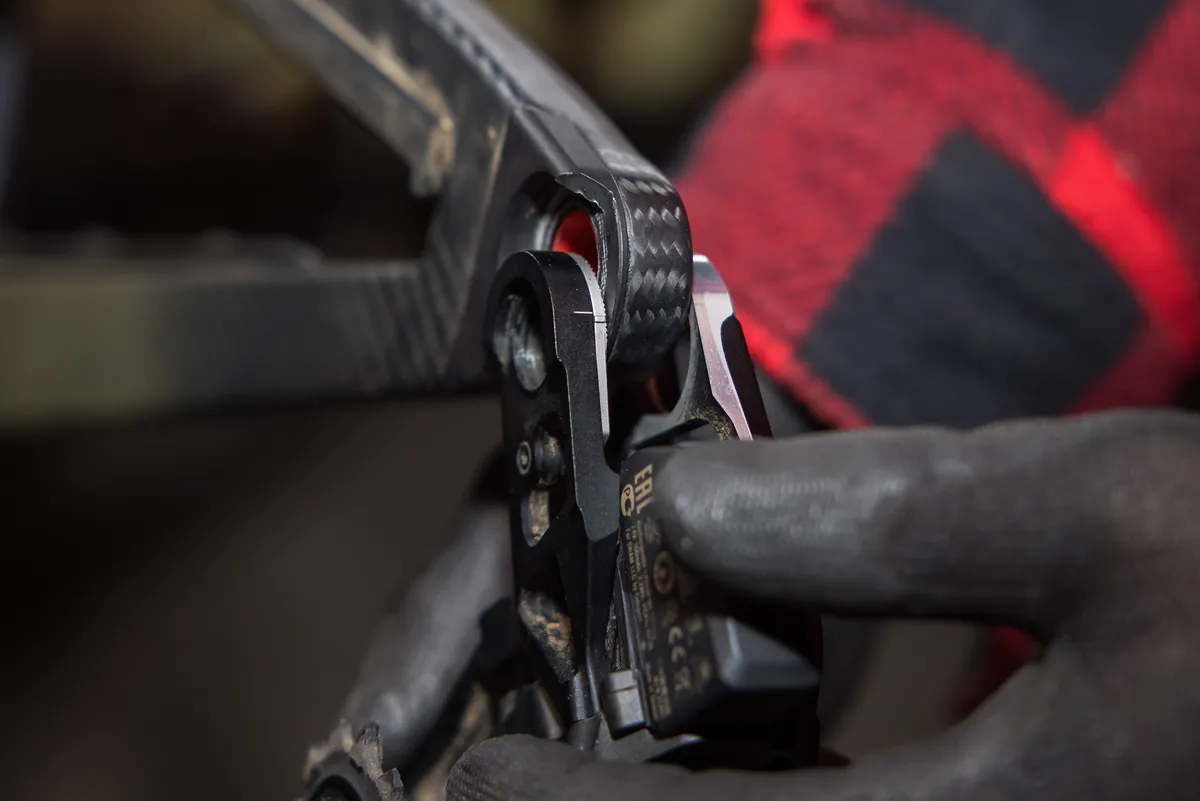
Full groupset installation (cranks, chainring, chain, cassette, derailleur and shifters) takes around 30 minutes.
Once the procedure has been performed, it's incredibly easy to replicate without instructions.
SRAM XX T-Type Eagle Transmission Powermeter AXS groupset performance

I tested the XX T-Type Eagle Transmission over a period of six months, racking up more than 35,000 metres of ascent and descent, 80 hours and over 1,000km of riding.
SRAM supplied a We Are One Composites Arrival 152 with the all-new XX Powermeter groupset fitted; a bike best suited to enduro-style riding.
The testing happened over the winter period, with conditions ranging from -5°C freeze-dried ground through to mild and sloppy mud, with plenty of dust, sand and rocks thrown in for good measure.
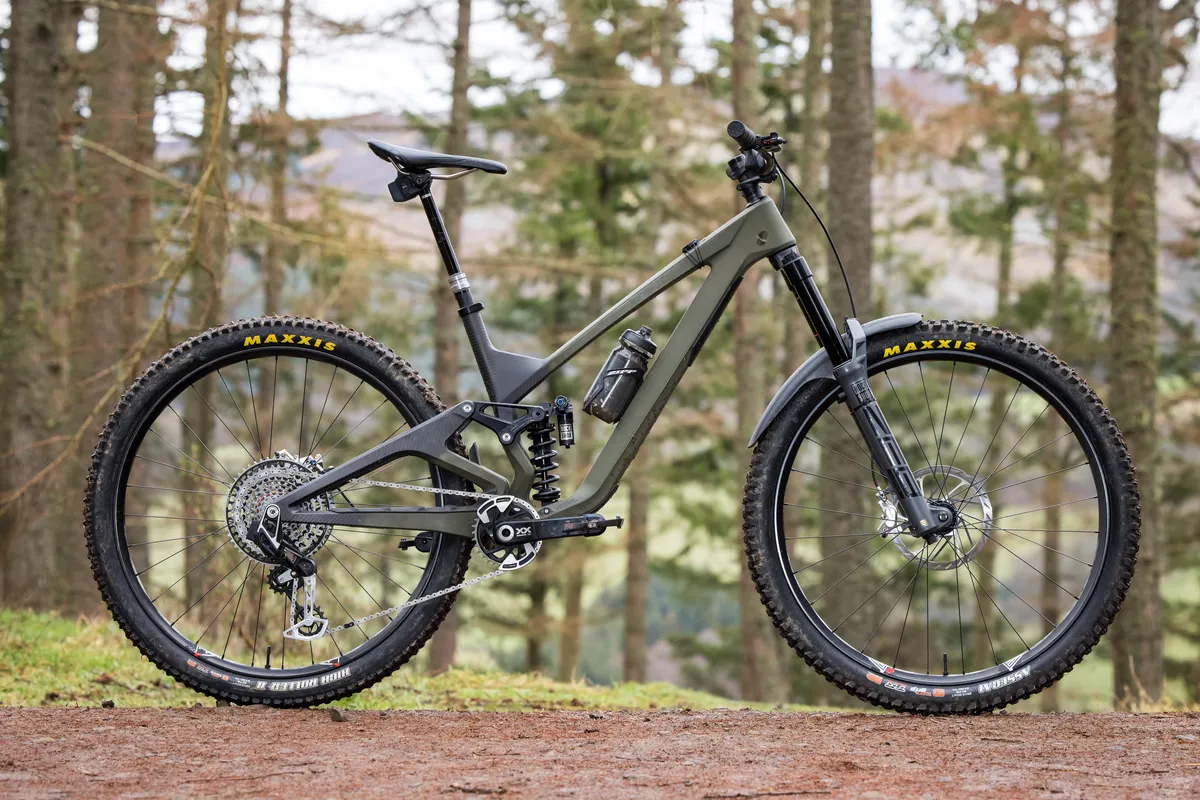
The bike has been maintained, cleaned and looked after. Arguably, the post-ride clean up routine has been a little overzealous, increasing the potential for water ingress.
Most of the testing happened in Scotland’s Tweed Valley, renowned for its gruelling, world-class cross-country riding, singletrack trails, and enduro and downhill tracks. Several months of riding in the valley are equivalent to a lifetime in drier, less extreme climates.
SRAM’s new T-Type Transmission, therefore, has had an incredibly thorough workout.
SRAM XX T-Type Eagle Transmission AXS 12-speed rear derailleur performance
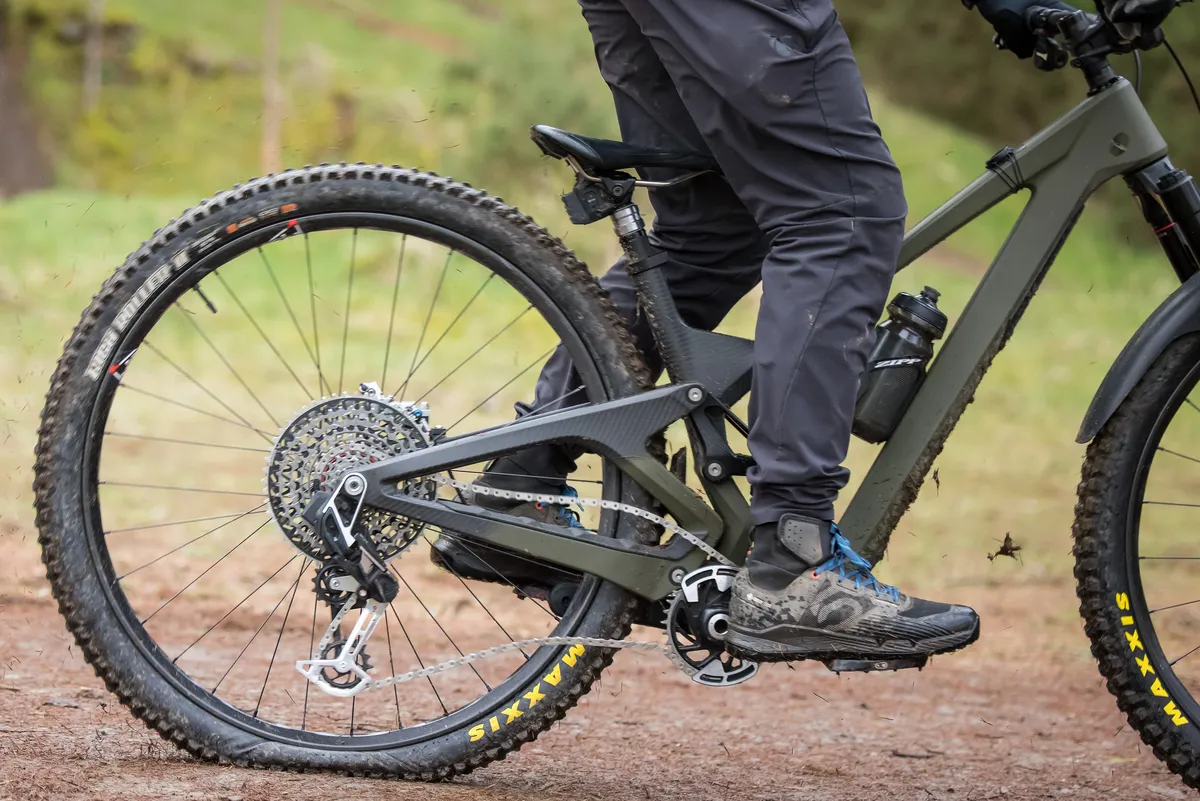
During the test period, I’ve received many legitimate comments from people airing concerns about strength and longevity.
They argue removing the derailleur hanger has eliminated the sacrificial component designed to break in an impact before the frame or derailleur will, saving you from a large bill.
In my experience with the new T-Type Transmission, you need not worry. My test sample has been banged, knocked, bashed and dragged through dirt, rocks and roots every time I’ve ridden it, and remains unscathed, as does the We Are One Arrival frame.
XX T-Type derailleur robustness
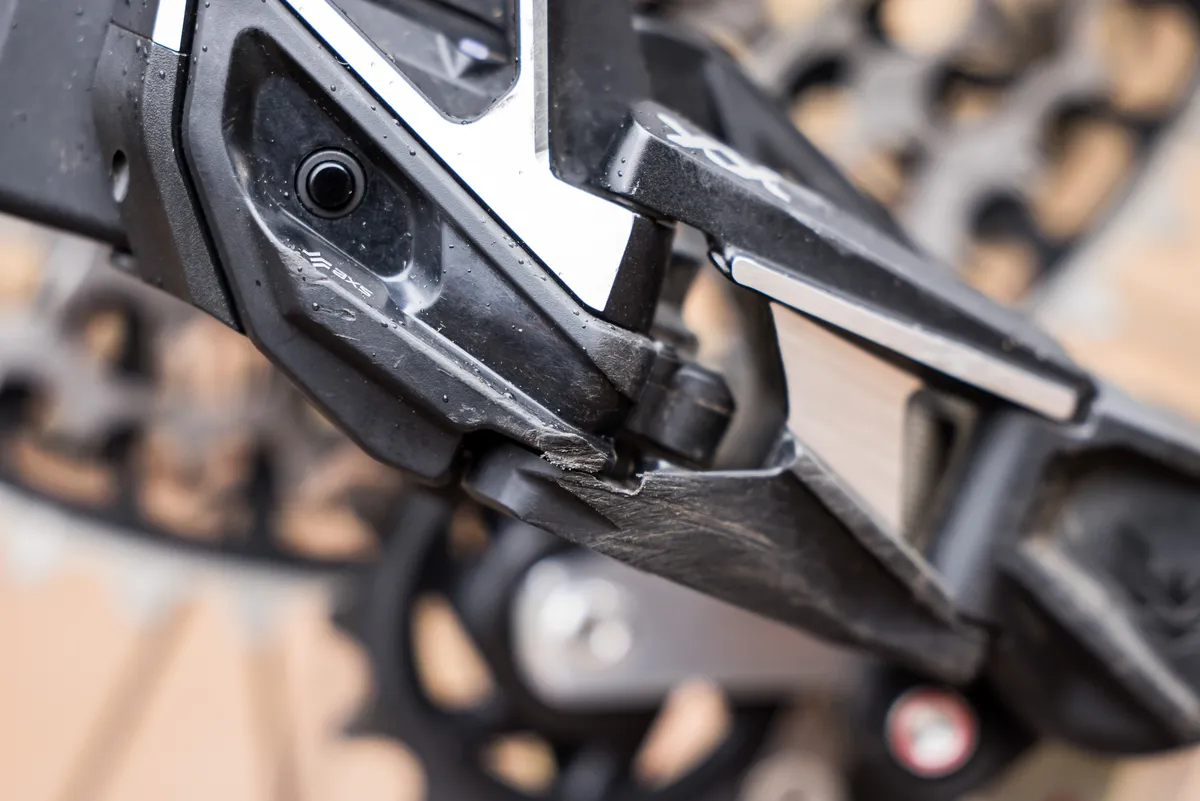
The derailleur is showing cosmetic signs of the abuse it has been subjected to. The cage is scratched, the skid plates scarred and the parallelogram bearing bashes, yet functionally it has retained its day-one performance.
None of its parts are bent or twisted, the Full Mount remains play- and slop-free, and the cage is perfectly true.
The join between the cage and main derailleur body (p-knuckle) remains in as-new condition. There has been no water ingress into the clutch/damper mechanism, indicating the sealing is impressive.
The forward inner parallelogram’s pivot has a small amount of play when manipulated from side-to-side. This doesn’t appear to affect performance and hasn’t worsened since I first noticed it after 700km of riding.
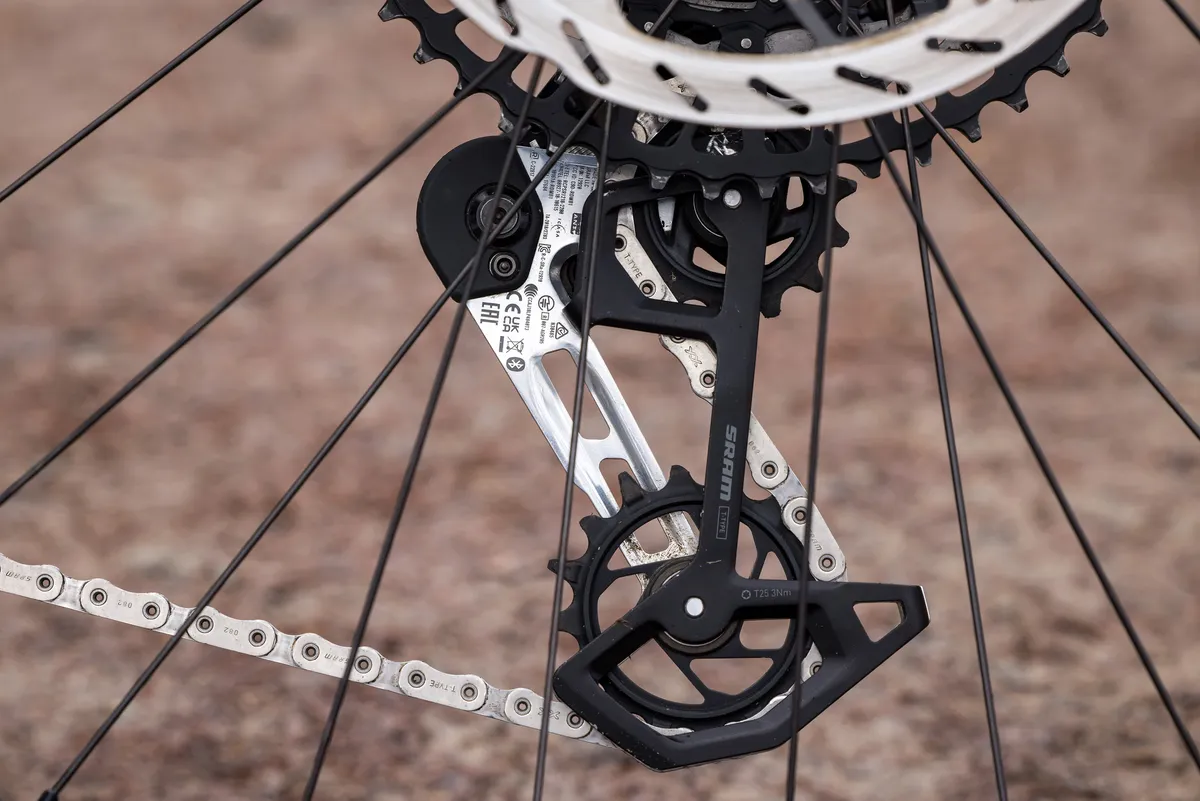
The pulley wheels are also play- and slop-free, while the teeth don’t appear to show any significant signs of wear or blunting.
Clearly, SRAM’s focus on durability and strength hasn’t been in vain.
In my experience, concerns regarding derailleur and frame damage by removing the derailleur hanger are totally unfounded.
The derailleur has been strong and robust enough to handle a torrent of unsympathetic riding, remaining damage-free.
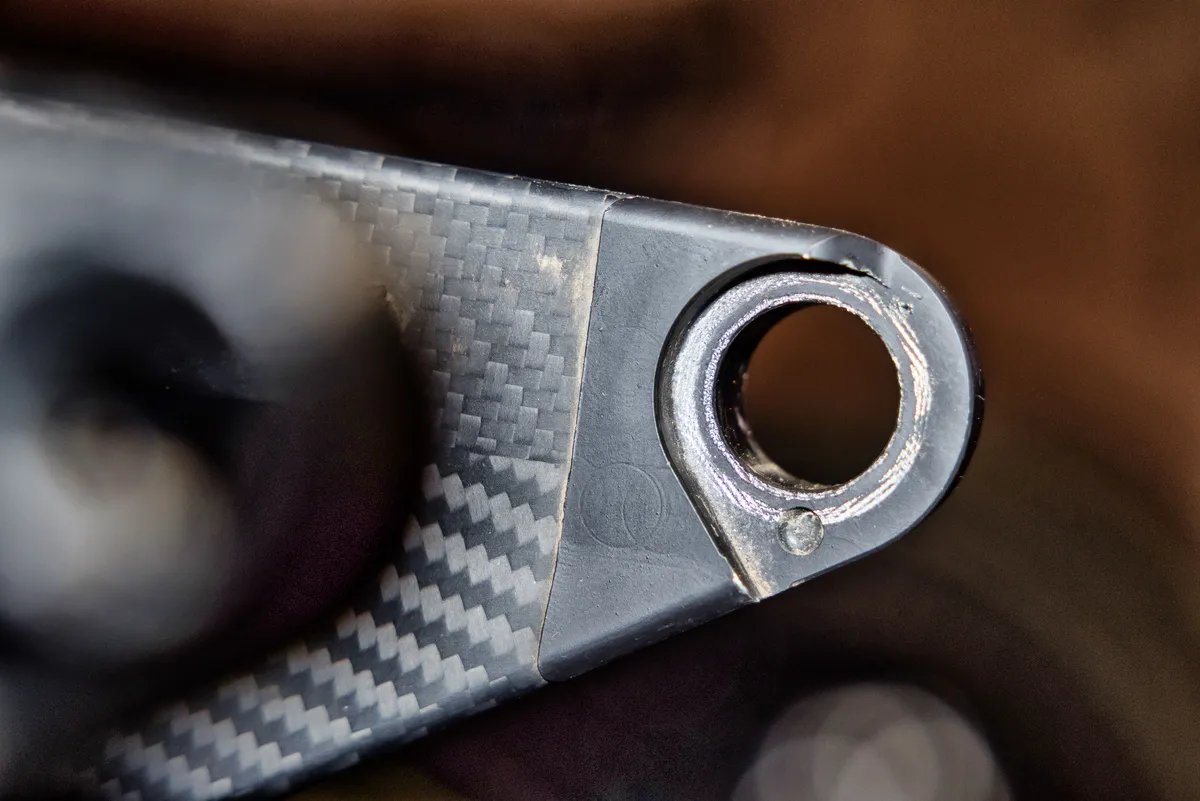
The Arrival’s carbon fibre frame’s Hangerless Interface dropout remains in perfect condition, indicating the frame isn’t any more likely to get damaged than bikes with a traditional derailleur hanger.
In evolving derailleur design, SRAM has significantly improved robustness and reliability.
Rebuilding the XX T-Type derailleur
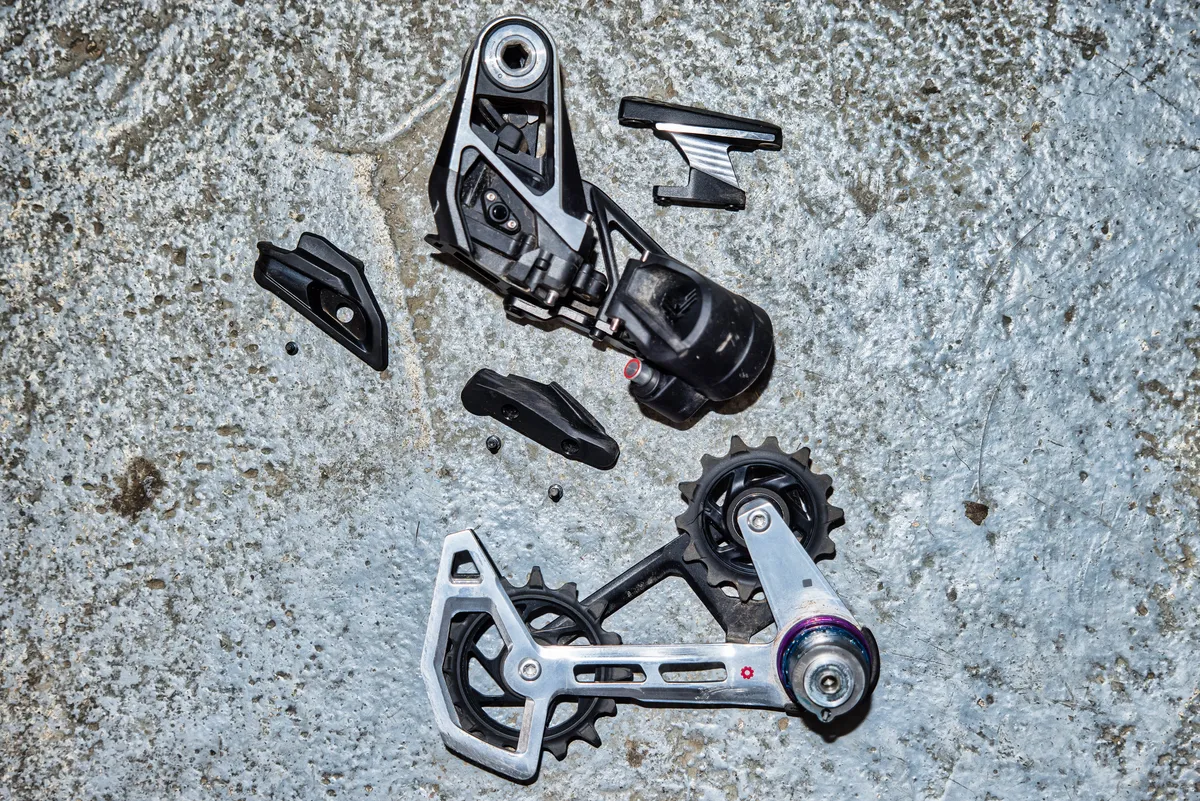
SRAM recommends the derailleur is removed from the bike to rebuild any of the parallelogram’s parts or remove the cage.
Derailleur removal means splitting the chain’s one-use Powerlock. When reassembling the drivetrain, a fresh Powerlink has to be used to reduce the risk of failed chains.
Requiring just a few common tools (2mm and 2.5mm Allen keys and a T25 Torx), rebuilding the derailleur is simple and convenient.
The small Allen key bolt heads on the skid plates and parallelogram linkage have proven to be relatively robust for their small size, but care needs to be taken.
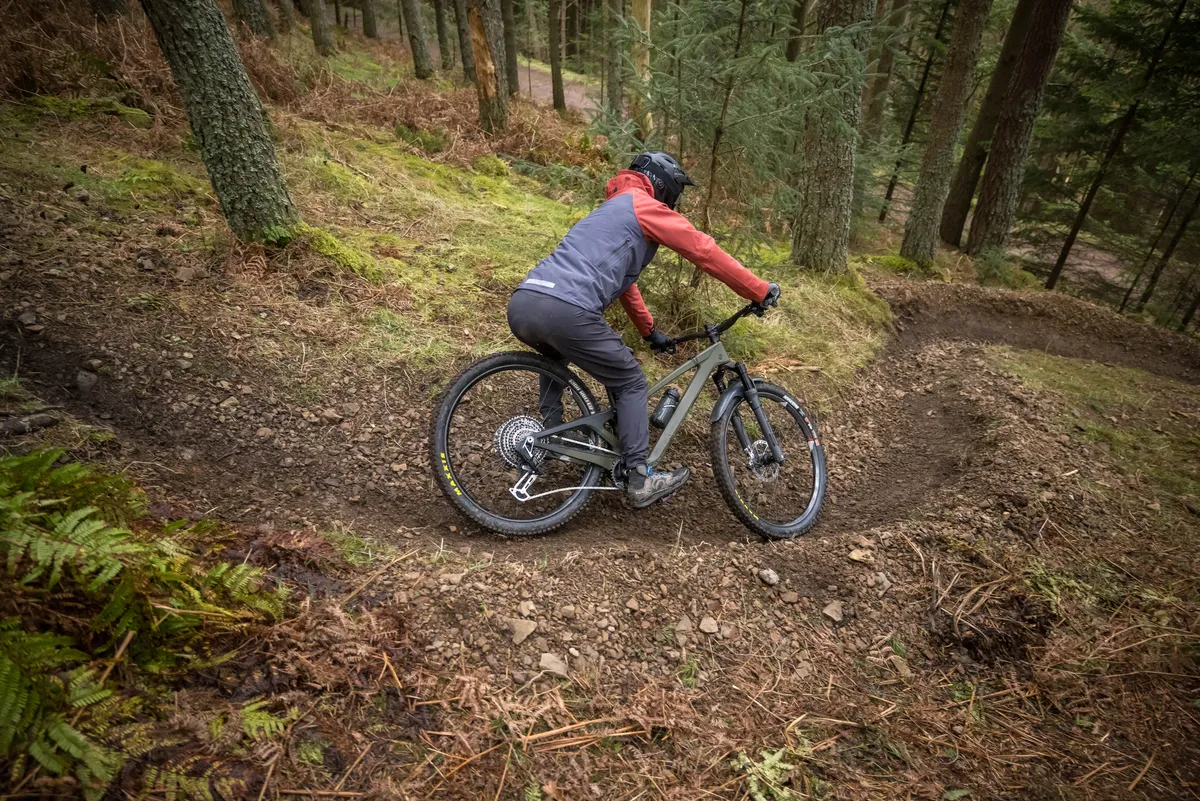
Using a torque wrench and adhering to SRAM’s torque recommendations is essential when rebuilding it.
Removal and replacement of the jockey wheels is simple, quick and straightforward, but SRAM’s torque specs should be followed exactly.
Cage removal is tool-free. It unscrews using a reverse thread, meaning turning it clockwise in relation to the derailleur’s p-knuckle removes it.
The cage isn’t spring-loaded, and the clutch components can’t fall out when it has been removed. This makes removal and reinstallation quick and easy.
XX T-Type derailleur shifting performance
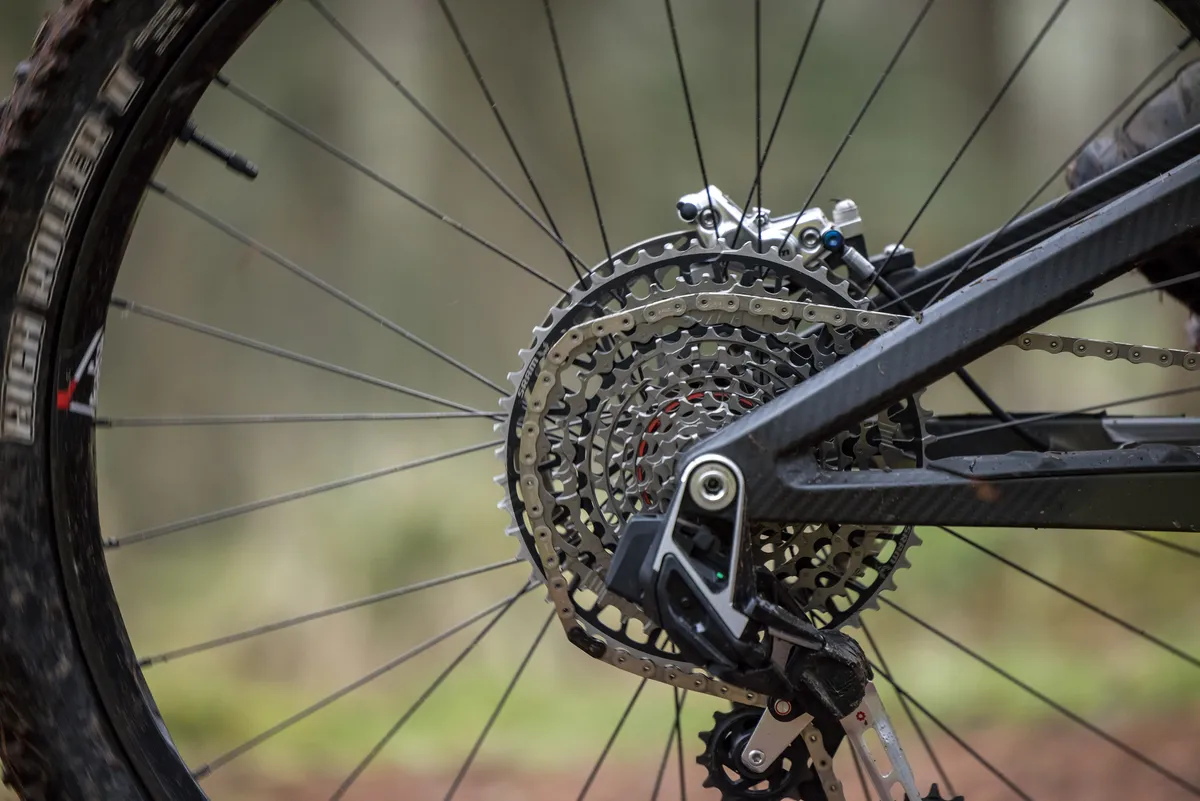
Shifts are crisp, quick and precise, and true to SRAM’s claims are incredible under load.
The relationship between Pod Controller button push and derailleur actuation is instantaneous and precise, and shifts happen when you're expecting them to.
Thanks to the derailleur’s shift mapping and cassette’s shift ramps, I’ve not experienced a single miss or failed shift during the test period, with the derailleur changing gear in an identical way, every time.
Shifts are also impressively quiet. It was impossible to get the derailleur to crash and bang the chain up or down the cassette, even when being very unsympathetic.

Arguably, shifts were quieter and smoother when executed under power. Instead of backing off during a shift, T-Type responded exceptionally to no change in cadence or pedal input.
This required a re-learning of how to shift, but felt natural very quickly and resulted in higher-paced climbing.
This will really benefit those riding electric bikes, where gear changes are notoriously unforgiving, and those who like to attack the climbs.
Shift dumping – where all or most of the gears are changed at once – isn’t possible on T-Type. The derailleur’s shift mapping stops it from selecting the next gear until it is able to shift.
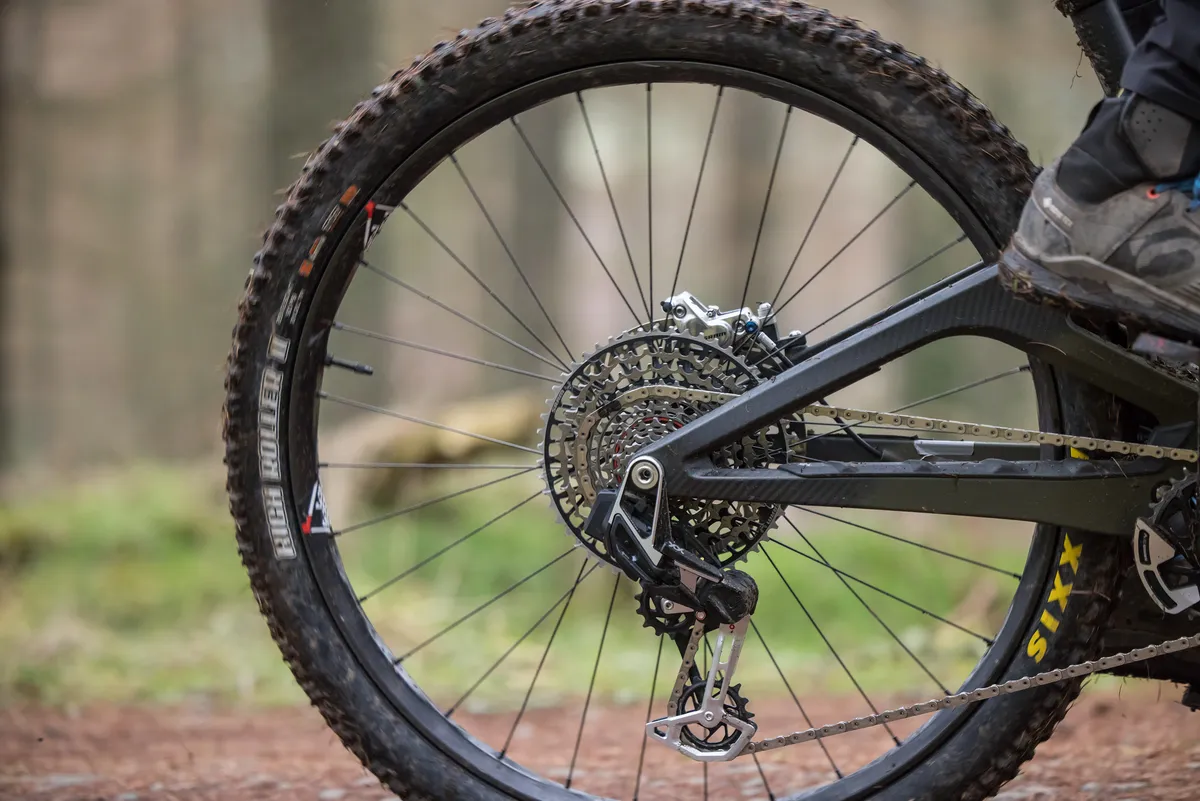
Shift dumping with the bike on a stand reveals this. The derailleur seems slow to move up or down the cassette, shifting only when it is lined up with a ramp.
Out on the trail, this was undetectable. Even successive, quick shifts weren’t delayed.
Shifting while pedalling hard on rough terrain was also very impressive. Suspension position, vibrations and bumps didn’t interfere with shift performance.
XX T-Type derailleur clutch performance

SRAM has increased the T-Type derailleur clutch’s tension significantly over the Eagle drivetrain AXS derailleurs.
This, coupled with a b-bolt that can’t rotate freely on its mounting point, means chain control is now impressive, and noise from chain slap is low.
Despite not running a chain device on the We Are One T-Type test bike, the chain hasn’t derailed once during the test period. In comparison, I regularly lose chains on bikes fitted with an Eagle drivetrain without a chain device.
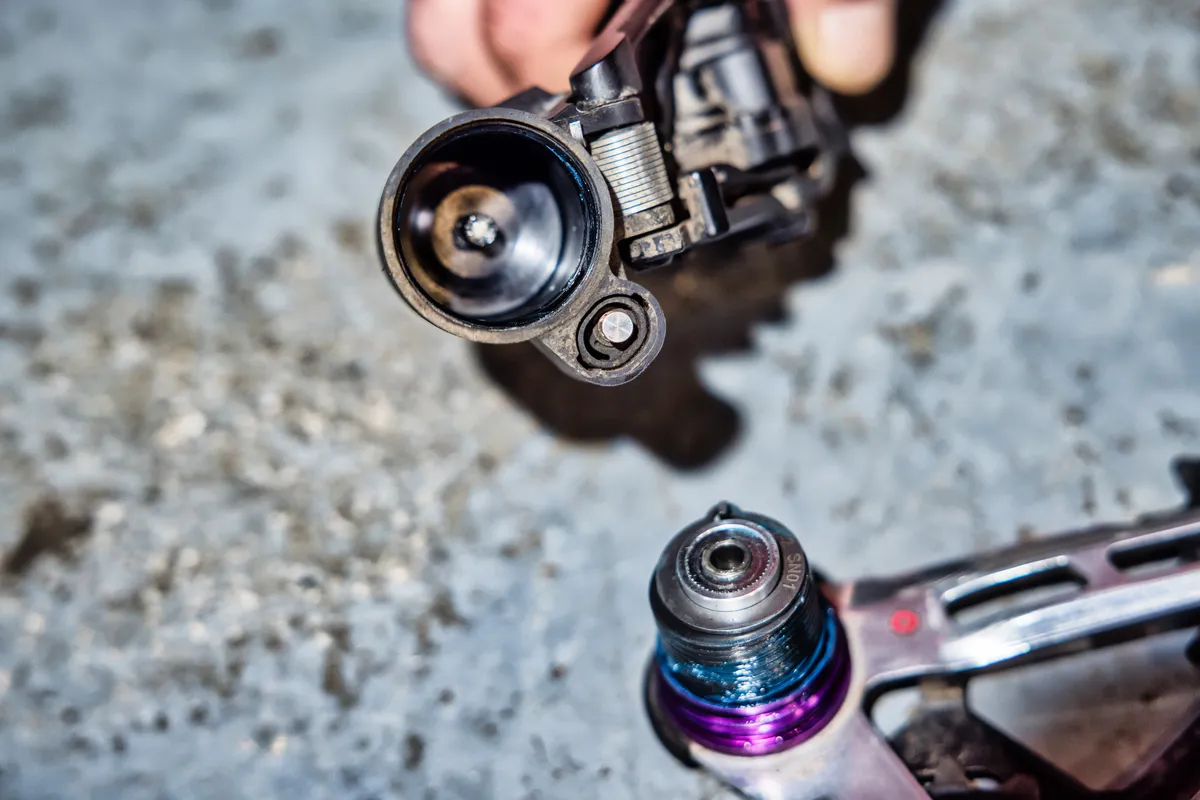
Further highlighting the improved chain control is the chainring tooth wear, where the chain exits the chainring.
In my experience, chainrings used with Eagle drivetrain AXS derailleurs show increased chainring tooth wear caused by the chain jumping up and down on the teeth. This is arguably an effect of an under-tensioned clutch and pivoting b-bolt.
XX T-Type derailleur Magic Wheel performance

SRAM’s T-Type Magic Wheel is impressive. The shape of its teeth expels objects that are in danger of being ingested as the chain runs through the derailleur, and the derailleur cage makes it virtually impossible for objects to enter it in the first place.
Objects as small as a 2mm Allen key are pushed away from the wheel as it spins.
Blocking the spokes of the Magic Wheel while it’s rotating causes the outer portion of the wheel to rotate on the stationary spokes.

While this increases friction through the drivetrain enough to make you notice there could be an issue, there’s not enough friction to cause chain jam or stop it from working.
I couldn’t intentionally test the Magic Wheel on the trail, but I’ve not had a single chain jam during the test period, indicating it works as intended by stopping issues occurring in the first place.
SRAM XX T-Type Eagle Transmission AXS Pod Ultimate Controller performance
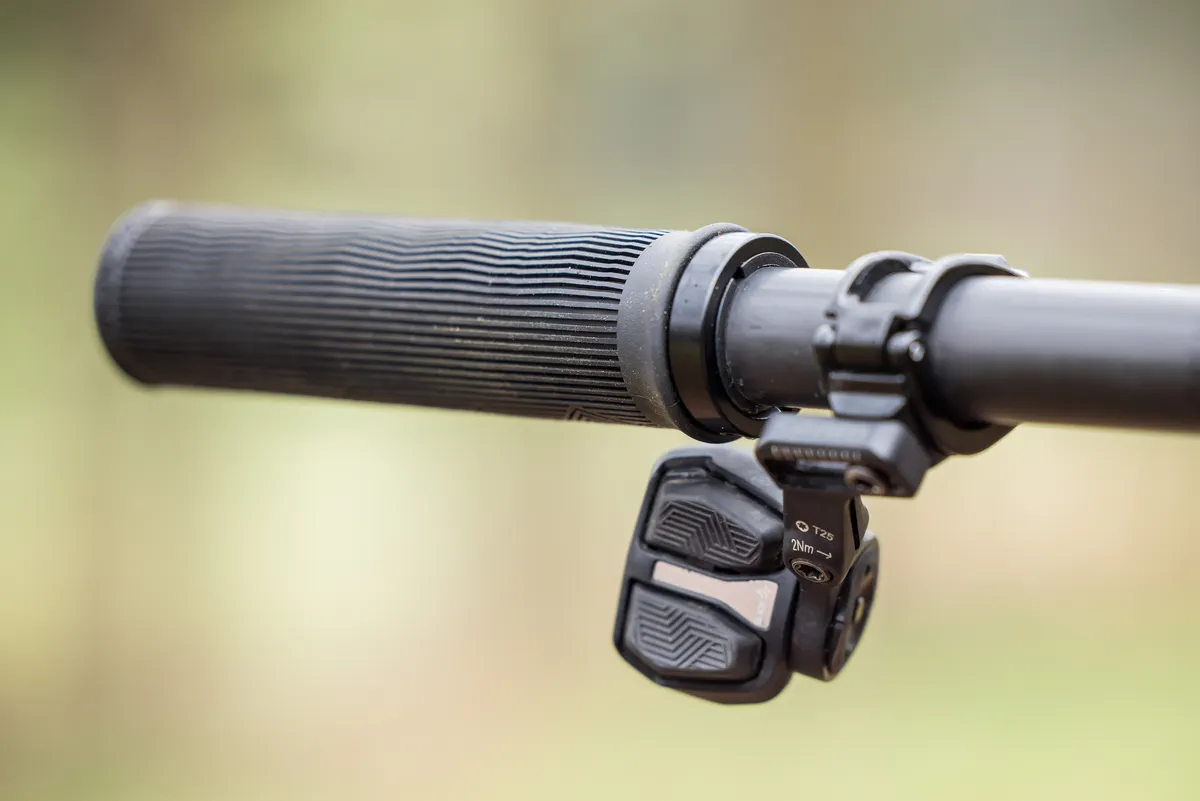
The Pod Controller addresses the criticisms of the analogue shifter copycat design of the AXS Controllers.
Its large, chunky buttons are easy to find and feel, even with thick mountain bike gloves, on or while moving over rough, bike-vibrating terrain.
Many will appreciate the replaceable buttons on the Pod Ultimate. I preferred the concave buttons to the convex ones, finding they were grippier and easier to stay in contact with.
SRAM has removed the third, rear-facing button from the AXS Controllers, limiting the Pod Controllers to two buttons, but I didn’t find this to be an issue.

The buttons are quick and easy to remove and haven’t unattached themselves when I didn’t want them to.
SRAM has increased the button-click threshold, requiring more force than AXS Controllers.
This has eliminated accidental shifting on rough ground, a problem many experienced with AXS Controllers.
While testing, I received comments about the Pod Controller’s shape and location below the bars, people suggesting they appeared to be in harm’s way.
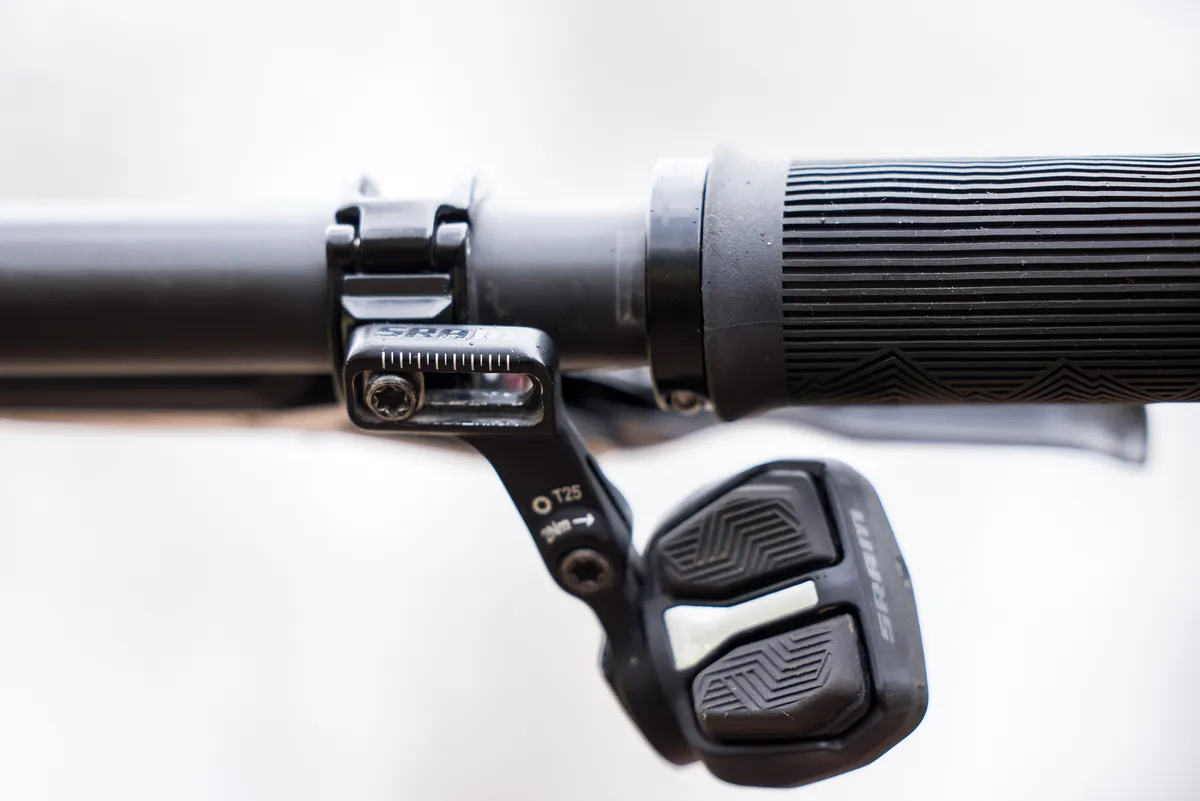
During the test period I’ve not damaged either Pod Controller (gear and dropper post) attached to my test bike.
The Bridge Clamp is a neat replacement for the Matchmaker X system, offering more sideways adjustment.
The Pod’s rotational adjustment offers an entirely new setup metric, and should make setting them up for individual needs easier.
The amount of shifter fore-aft adjustment on the brake lever remains unchanged from Matchmaker X.
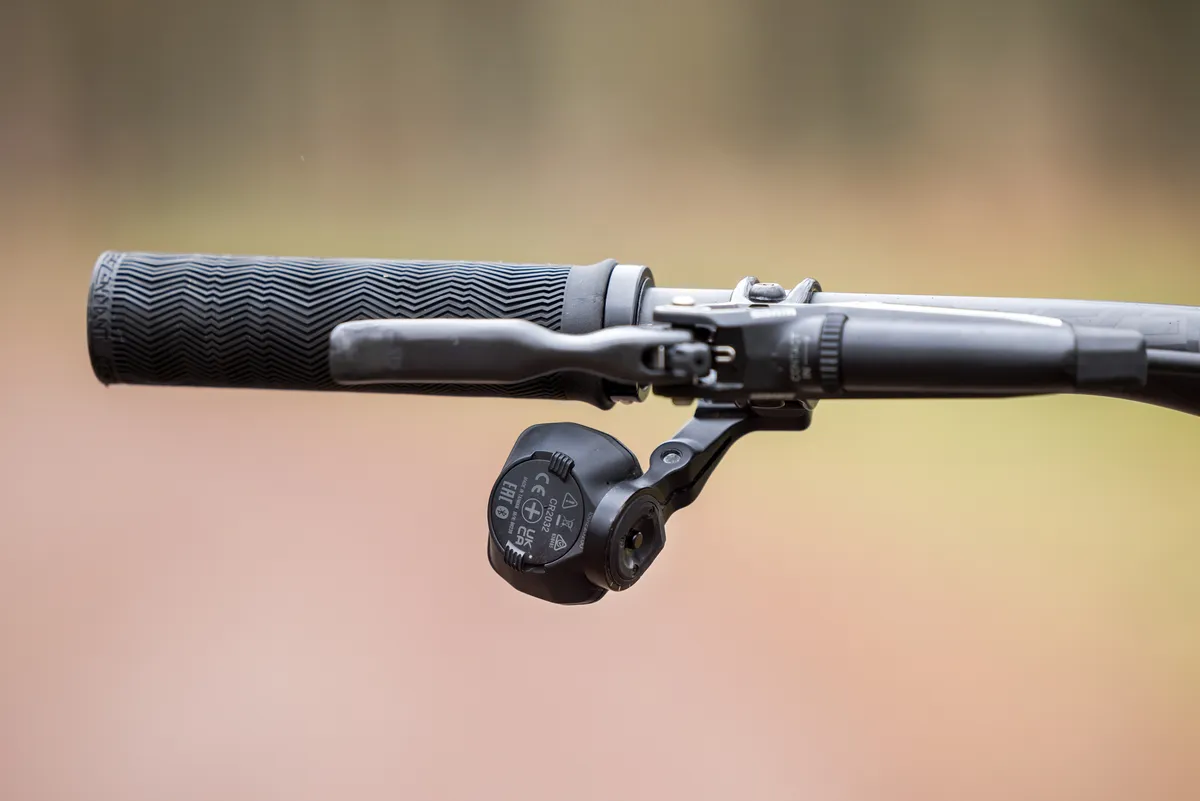
The Pod Controllers feel further away from the grips than the AXS Controllers. For my tastes, they needed to be run at their maximum forward position, leaving no room for additional adjustment.
This might not be an issue for everyone using the Bridge Clamp, and the Infinity Clamp offers more fore-aft adjustment, solving the issue altogether.
Cassette and chain
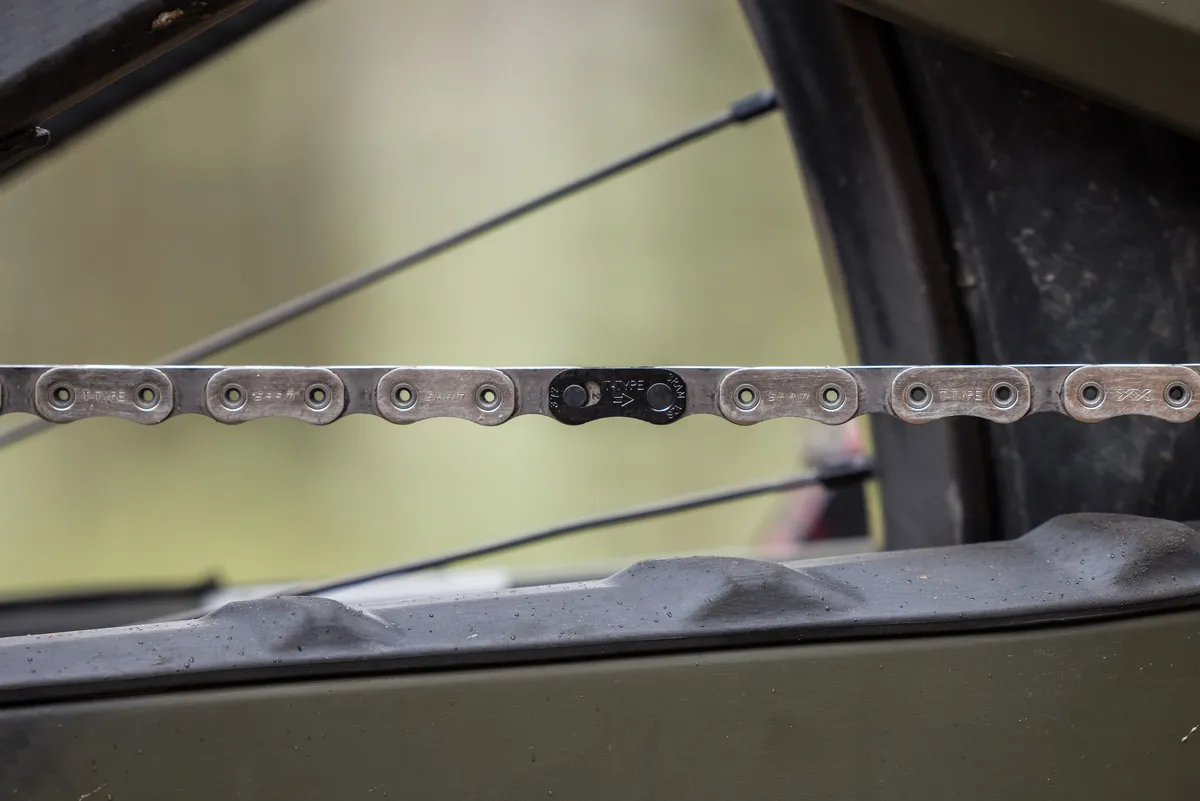
In decreasing the gaps between the 52t Eagle cassette sprocket and the next two gears, SRAM has addressed another of the Eagle drivetrain’s criticisms.
The jump between the 42t and 52t cassette sprockets was too big, where changing gear resulted in a large difference in pedalling cadence to maintain speed.
Riders found the 42t cassette sprocket too high to use regularly, preferring to ride slower or at a higher cadence in the 52t sprocket.
Bringing the 38t and 44t sprockets closer to the 52t means they’re more usable more regularly.
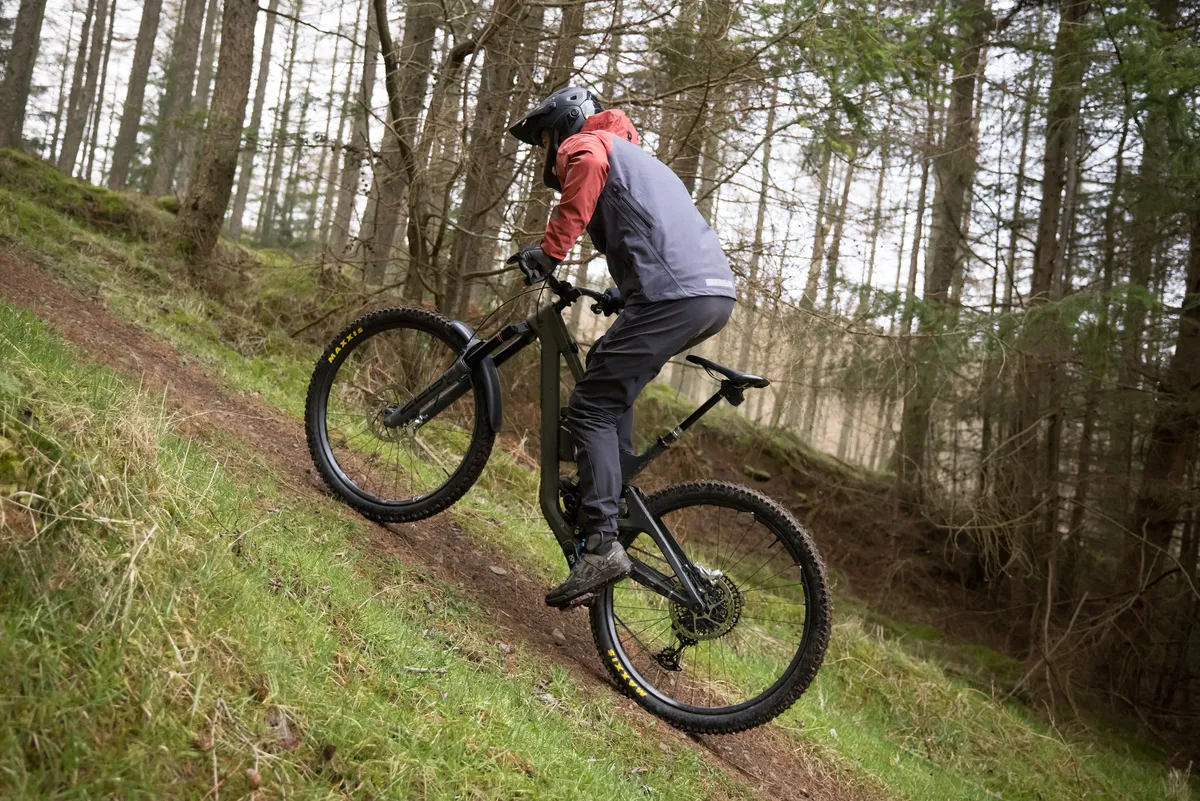
I frequently used the 38t and 44t gears when I would usually have been in the 52t sprocket going much slower.
The largest sprocket now fulfils its original aim as a true bail-out gear, rather than the riding gear it ended up being on Eagle drivetrains.
As with the derailleur, shifting has been impeccable.
SRAM’s work on the shift ramps pays dividends on the trails, where each shift is crisp, smooth, quick and accurate. Shift consistency, whether on or off power, is one of T-Type’s best traits.
The chain and cassette run quietly over one another, even when they’re covered in mud, water and grime from wet-weather riding.
T-Type chain and cassette wear
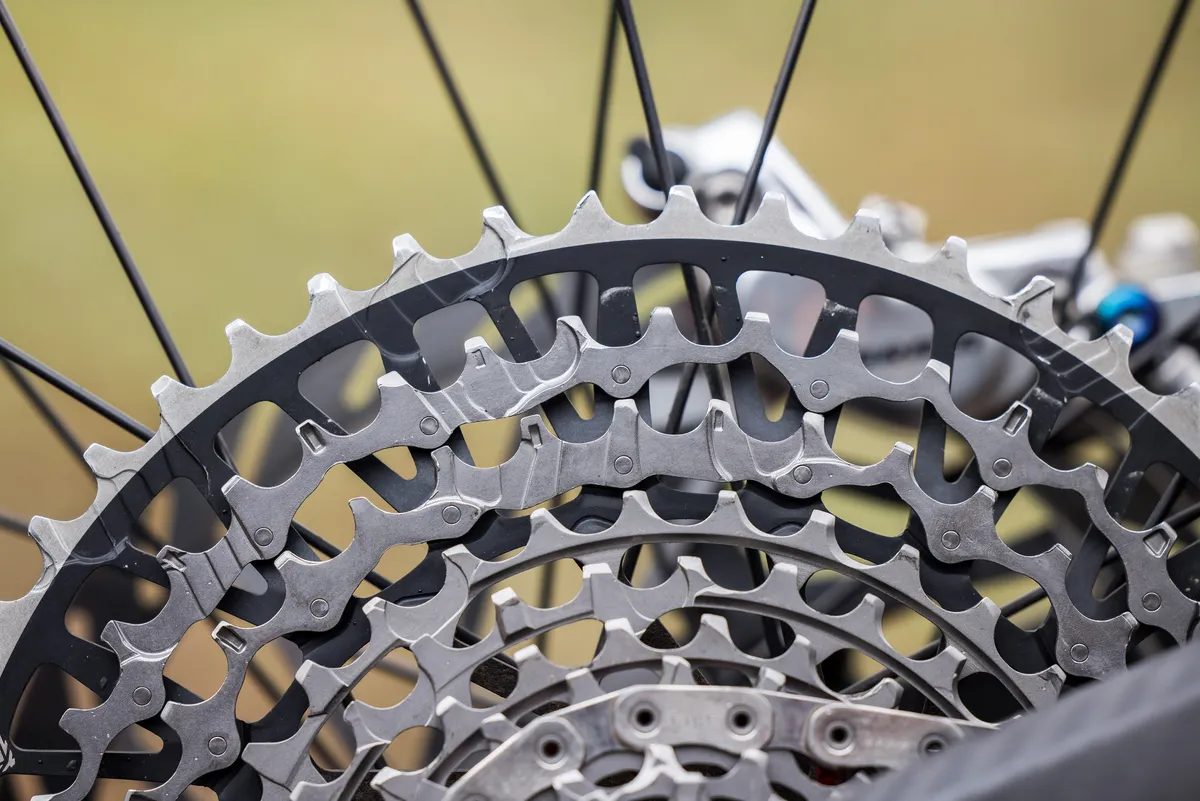
Chain and cassette wear appears to be minimal.
The cassette is showing no signs of scoring, damage or marking caused by shifting.
Compared to previous-generation Eagle drivetrain cassettes, the T-Type version is more robust and less prone to cosmetic wear, thanks to its polished teeth.
Using a chain wear tool, the T-Type chain with 1,000km of use was showing zero signs of wear compared to a new one.
While I can’t comment on the outright strength of the chain because I can’t test it accurately, neither it nor the Powerlock have snapped during the test period.
SRAM XX T-Type Eagle Transmission Powermeter crankset with 32t T-Type Direct Mount
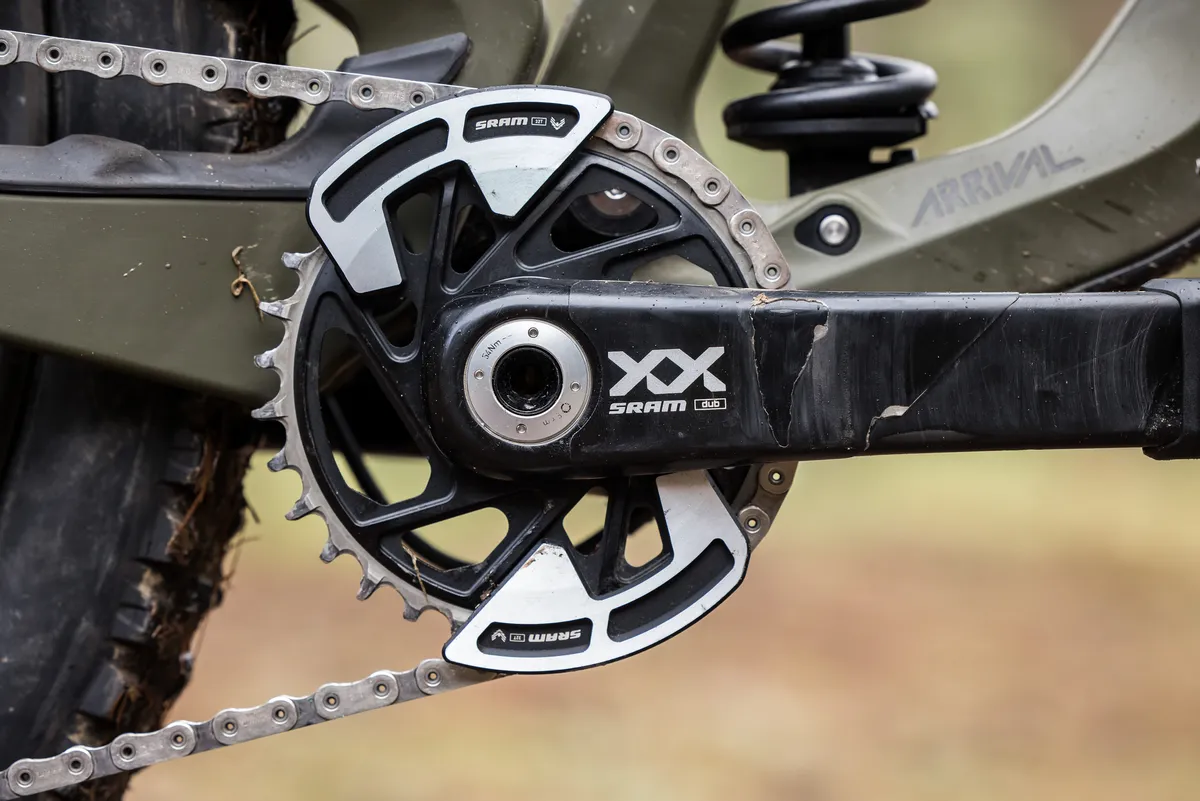
SRAM’s T-Type XX-level cranks are robust, brushing off rock strikes and general use well.
The 3M protective tape attached to the outer surface of the cranks appears to be more robust and durable than previous versions.
After 800km of riding, it has begun to wear through, but I am notorious for rubbing pedal cranks and frames with my feet.
I couldn’t definitively test crank strength or stiffness, but didn’t feel them flexing during the test period.
The chainring is also incredibly robust.
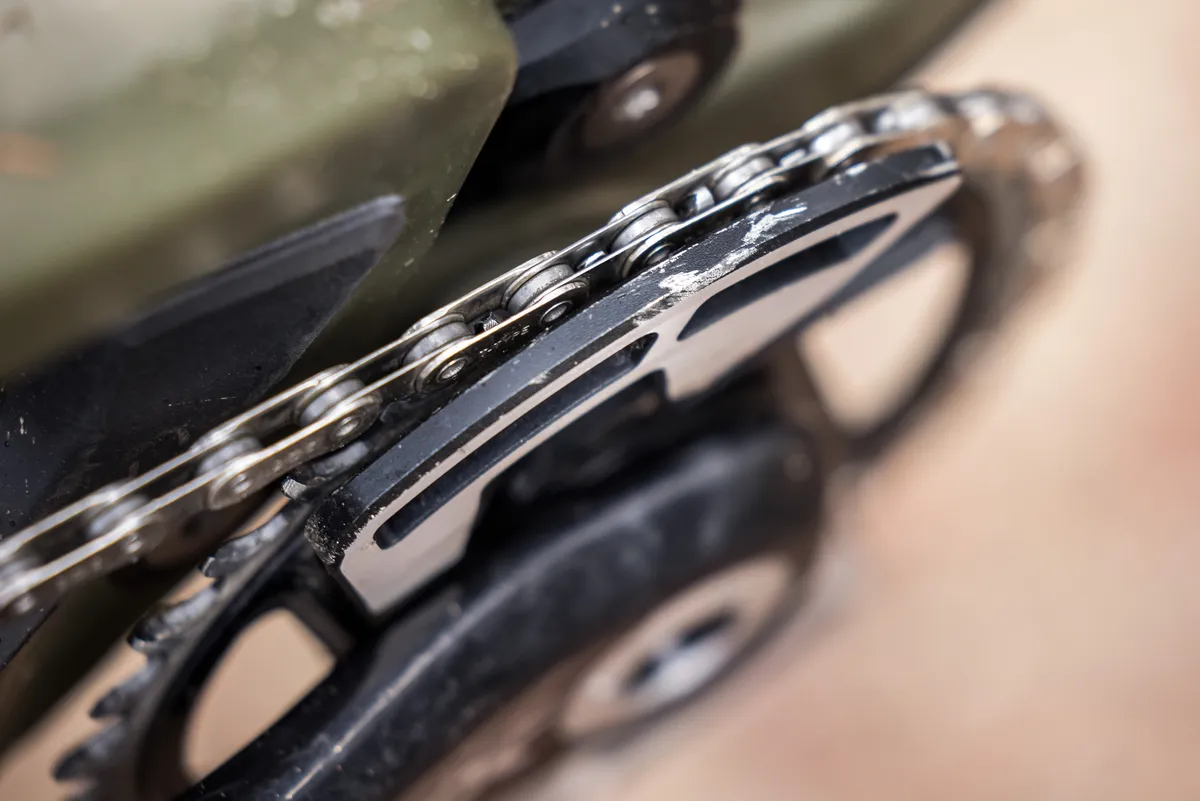
Its teeth have resisted wear, not becoming hooked or damaged through use.
Chain suck (where the teeth don’t release the chain as it comes off the chainring) has been non-existent, even once it was covered in wet, sticky mud or was running lube-free.
It has remained true during the test period, despite some Danny MacAskill-inspired moves.
Hard, high-force hits, and bashes on rocks and fallen down trees, haven’t resulted in any damage, buckling or deformation of the ring, or its bash guard components.
In my experience, XX’s chainring, bash guard and carbon fibre cranks are incredibly tough.
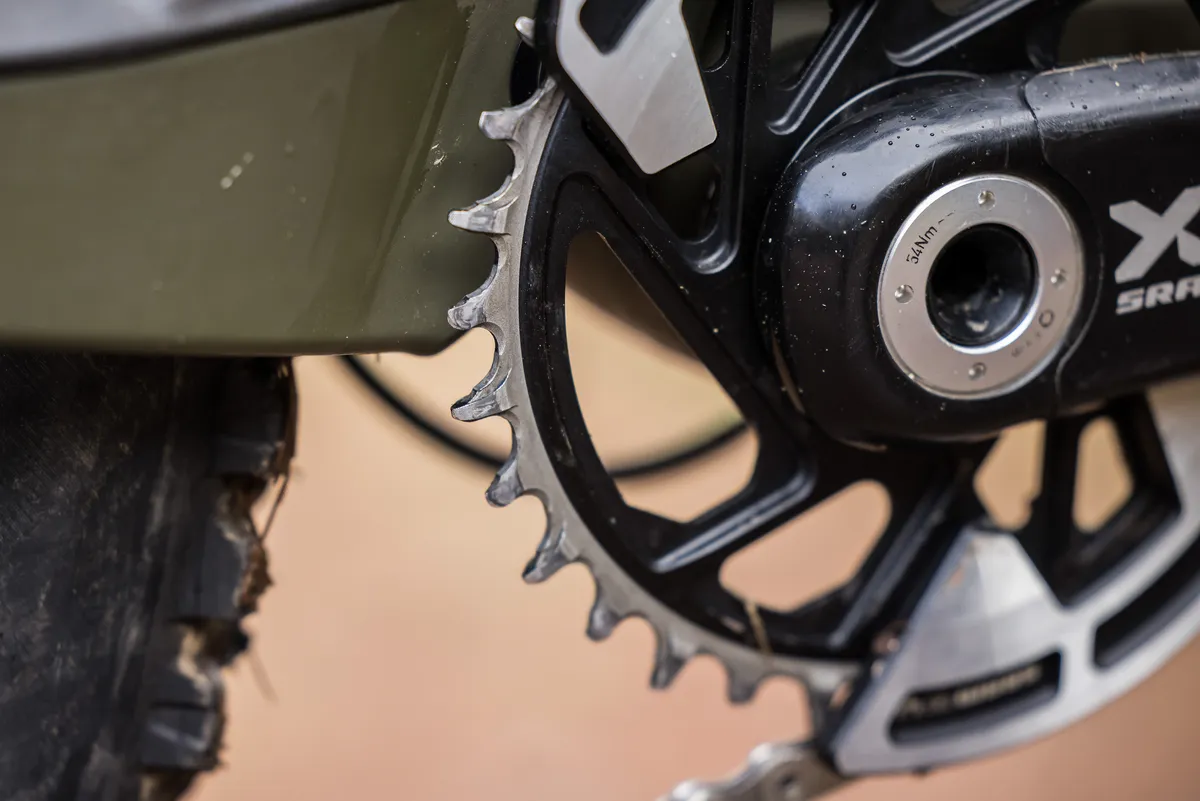
Chain retention has also been excellent, helped by the derailleur’s increased clutch tension. I haven’t lost the chain once during the test period, despite the We Are One test bike not having a chain device.
In my experience of an abundance of lost chains with Eagle AXS drivetrains, T-Type chain retention is a vast improvement.
Of course, not every rider (including some of BikeRadar’s testers) has had as many issues as me with Eagle AXS drivetrain chain derailments, but even if they haven’t they’ll still benefit from the quieter-running T-Type system with less chain slap.
XX T-Type DUB-PWR power meter performance
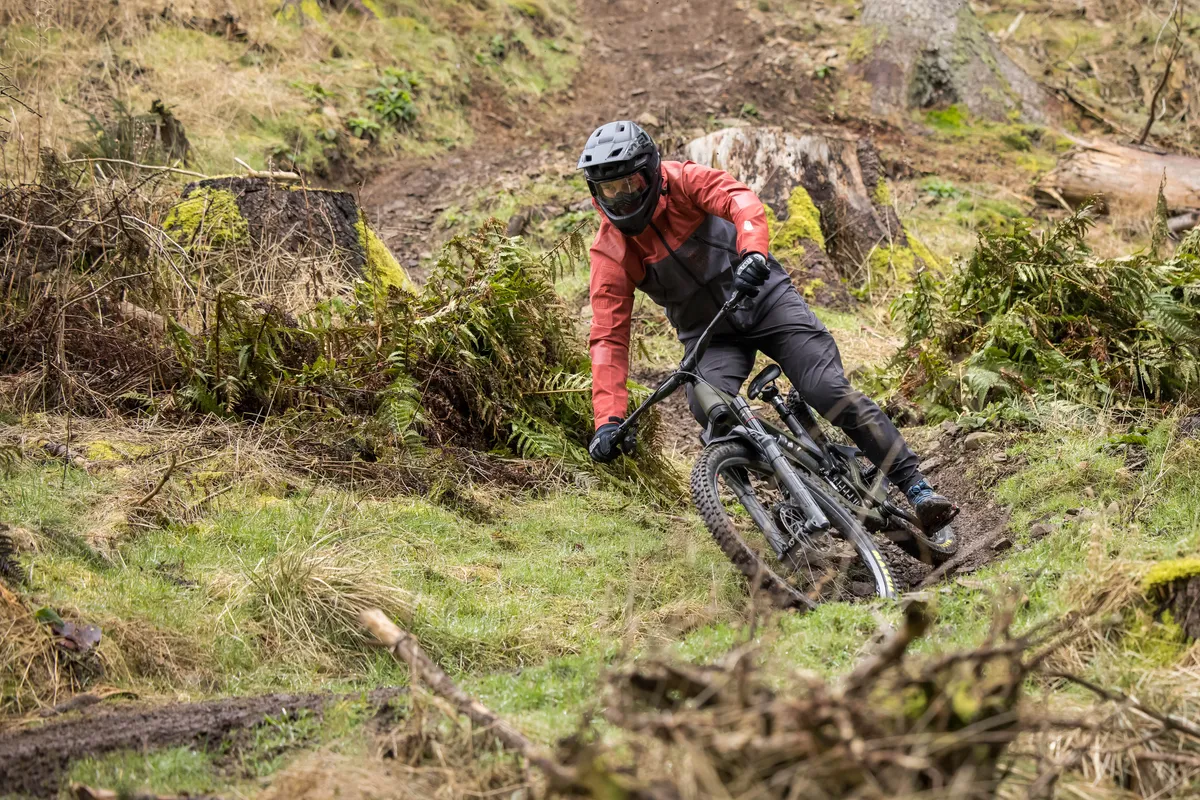
The crank spindle DUB-PWR power meter is an excellent addition to the groupset.
Although its single-sided design means it doesn’t have left-right power output readings, the amount of data available will be plenty for most riders.
Setup, pairing and general connectivity with the SRAM AXS smartphone app and GPS head units such as Garmin’s Edge 830 is intuitive and reliable.
It appears to be fairly resistant to the elements. However, when the battery shuttle was left in the bike for several weeks, its copper connectors began to show signs of corrosion, hinting at some humidity issues.
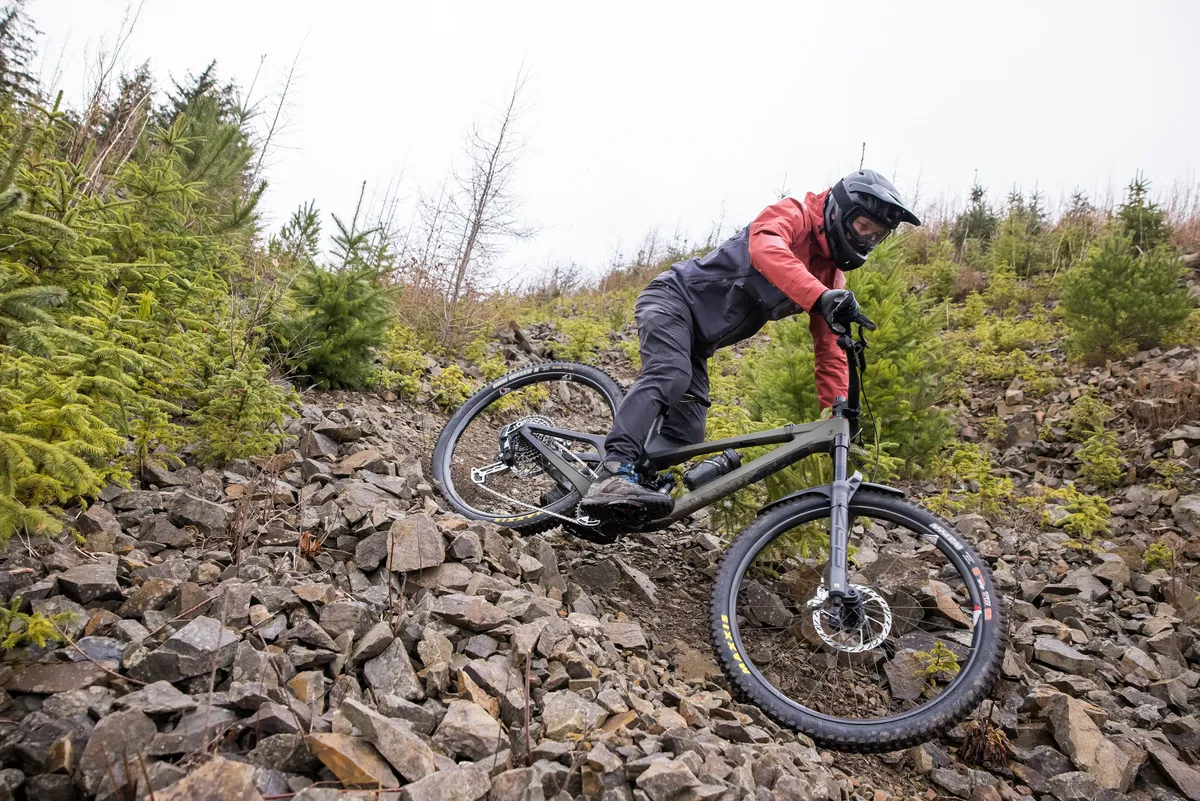
Cleaning the electrical connectors and applying some dielectric grease appears to have prevented further corrosion.
Battery life isn’t as good as SRAM’s 400-hour claims, my test sample requiring replacement after 60 hours of riding.
It is not compatible with alkaline or NiCd batteries, working only with lithium ones.
I couldn’t test SRAM’s +/- 3 per cent accuracy claims because I don’t own any additional power meters. However, it hasn’t produced any spurious readings and the power read-outs appear consistent with my perceived effort and heart rate.
How does it compare to SRAM XX1 Eagle AXS and Shimano XTR M9100?
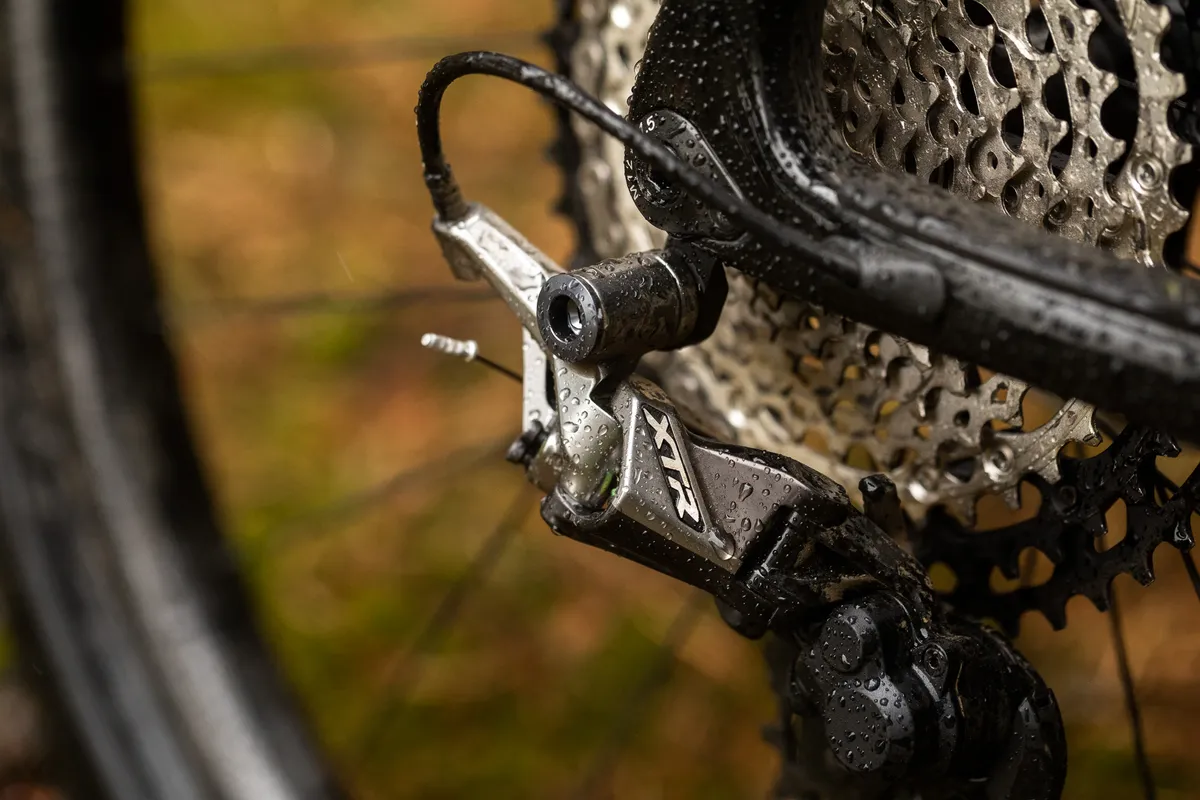
Starting with cost, when I tested SRAM’s halo Eagle drivetrain groupset – XX1 Eagle AXS – it retailed for £1,958 / $1,949 / €2,299 / AU$2,783.
That’s quite a bit less than the T-Type XX equivalent, which costs £2,465 / $2,299 / €2,750, although for the price you get the in-built DUB-PWR power meter.
Shimano’s range-topping XTR M9100 retails for a mere £1,125.94 / $1,469.94 / AU$2,134.
The all-new XX T-Type Eagle Transmission Powermeter AXS groupset weighs 1,785g.
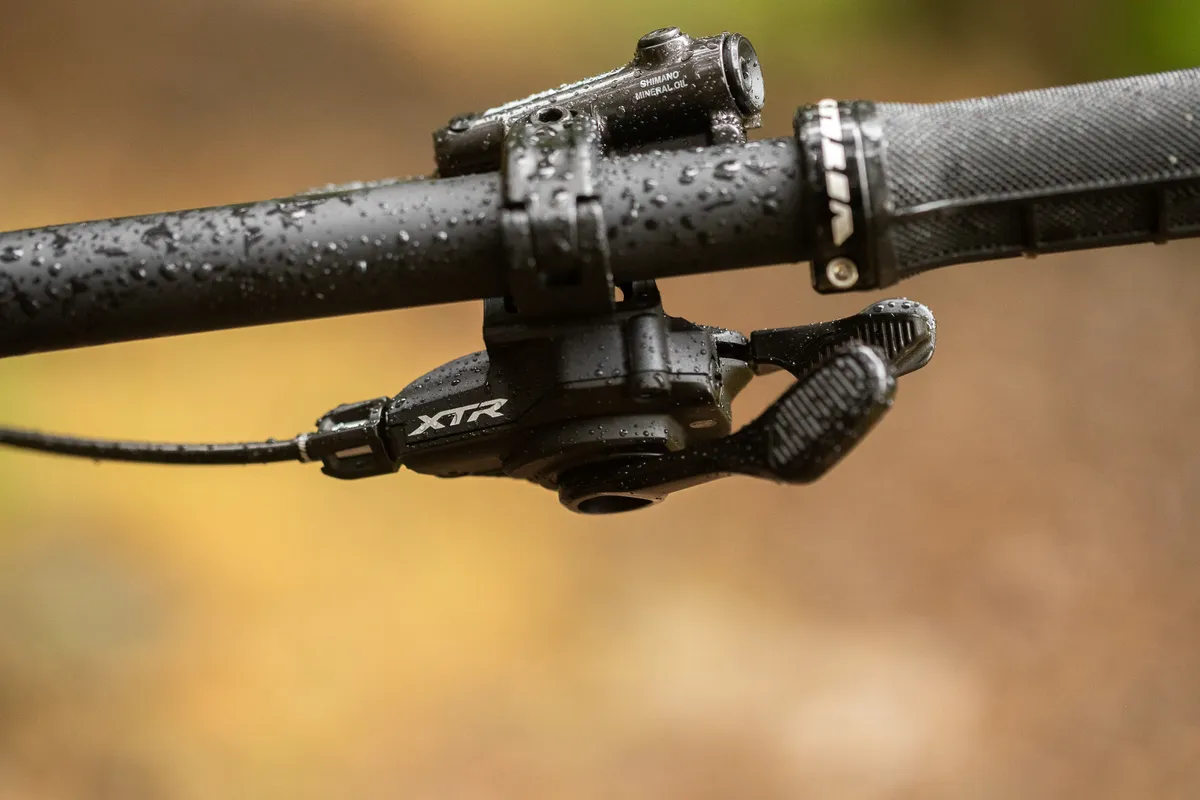
Compared to the XX1 Eagle AXS drivetrain, it’s 232g heavier, at 1,533g.
Lined up against XTR M9100, it’s 252g heavier, the equivalent Shimano groupset tipping the scales at 1,543g.
This makes XX heavier than the competition’s range-topper, and the previous-generation XX1.
If you’re looking for the lightest T-Type drivetrain, XX SL without a power meter weighs 1,533g. This is the same as the previous-generation XX1 Eagle AXS group, and lighter than Shimano’s XTR M9100 by 10g.
Installation and setup
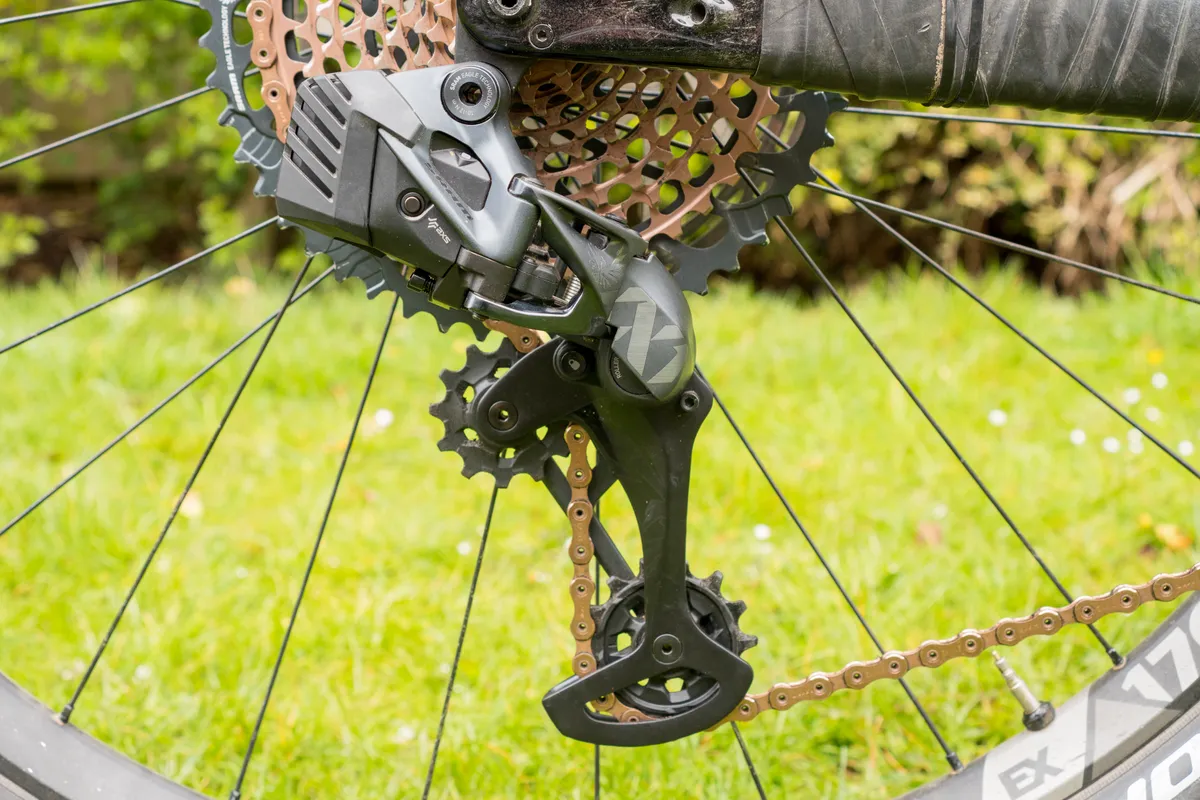
T-Type’s installation and setup process is easier than both Eagle drivetrain systems and Shimano’s offerings. It requires no dedicated tools (SRAM’s chain gap tool, for example), chain measuring techniques (both SRAM and Shimano) or back-of-derailleur-cage setup line b-tension adjustment (Shimano).
With no limit screws, b-tension adjustment, chain-length measurement or cable-tension adjustment, T-Type looks and feel generations ahead of the current crop of traditional drivetrains.
For some, this alone will be enough to warrant the upgrade, but T-Type’s advantages don’t stop at how easy it is to install and set up.
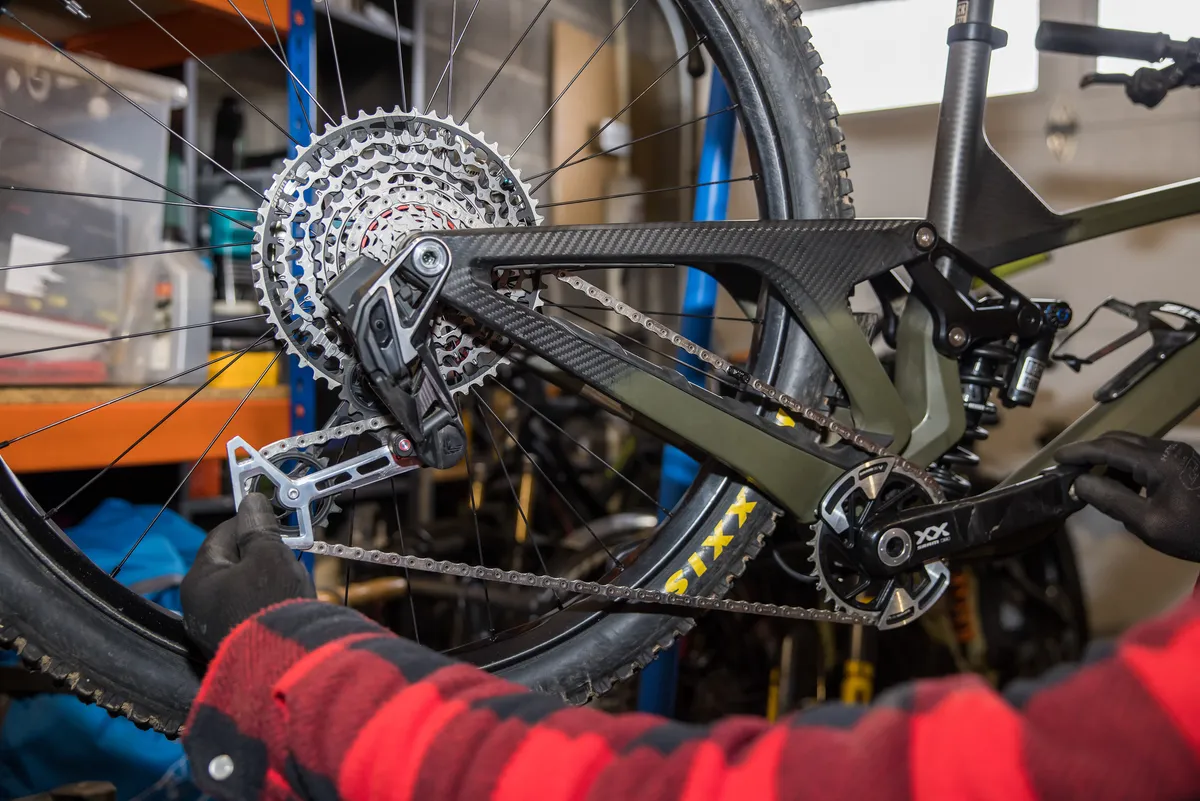
Making sure your frame’s Hangerless Interface is free of paint and perfectly grease- and mud-free is also an essential step. One of my test bikes, a Nukeproof Giga, had a small amount of paint in the dropout that needed to be removed before I could install the derailleur’s bushing frame insert correctly.
The only oddity is that with the rear derailleur removed from the frame it's not possible to fit and fasten the rear wheel because the wheel axle – which screws directly into the derailleur’s Full Mount design – has nothing to screw into.
On-trail performance

T-Type’s chain control is impressive; the only trade-off for this is a minor reduction in battery life compared to Eagle AXS derailleurs.
The clutch still lacks the adjustability of Shimano’s 12-speed derailleurs, and their tension can be increased vastly even compared to T-Type.
In this respect, riders looking for the most chain control will still want to use Shimano derailleurs.
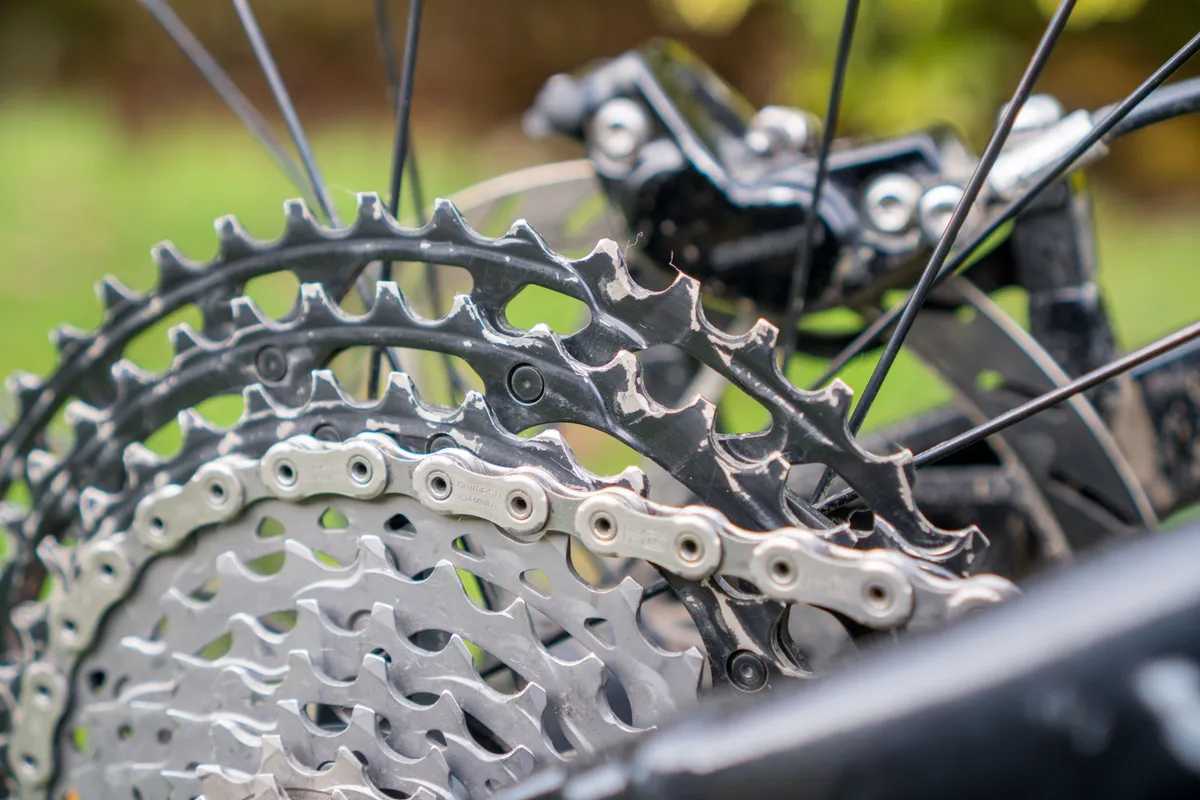
Shimano drivetrains previously offered the best on- and off-power shifting, but its crown has been taken by T-Type. Shifts are class-leading, whether you’re hard on the pedals or not, making SRAM’s new groupset seriously impressive.
T-Type derailleur shift mapping and cassette shift ramps are big contributors, but removing the analogue shifting of a gear cable and shifter paddle also contributes to eliminating missed or clunky shifting.
Unlike Eagle AXS drivetrains, you don’t need to back off the power as you shift with T-Type, and it's a marked step forward for SRAM.
Robustness and repairs
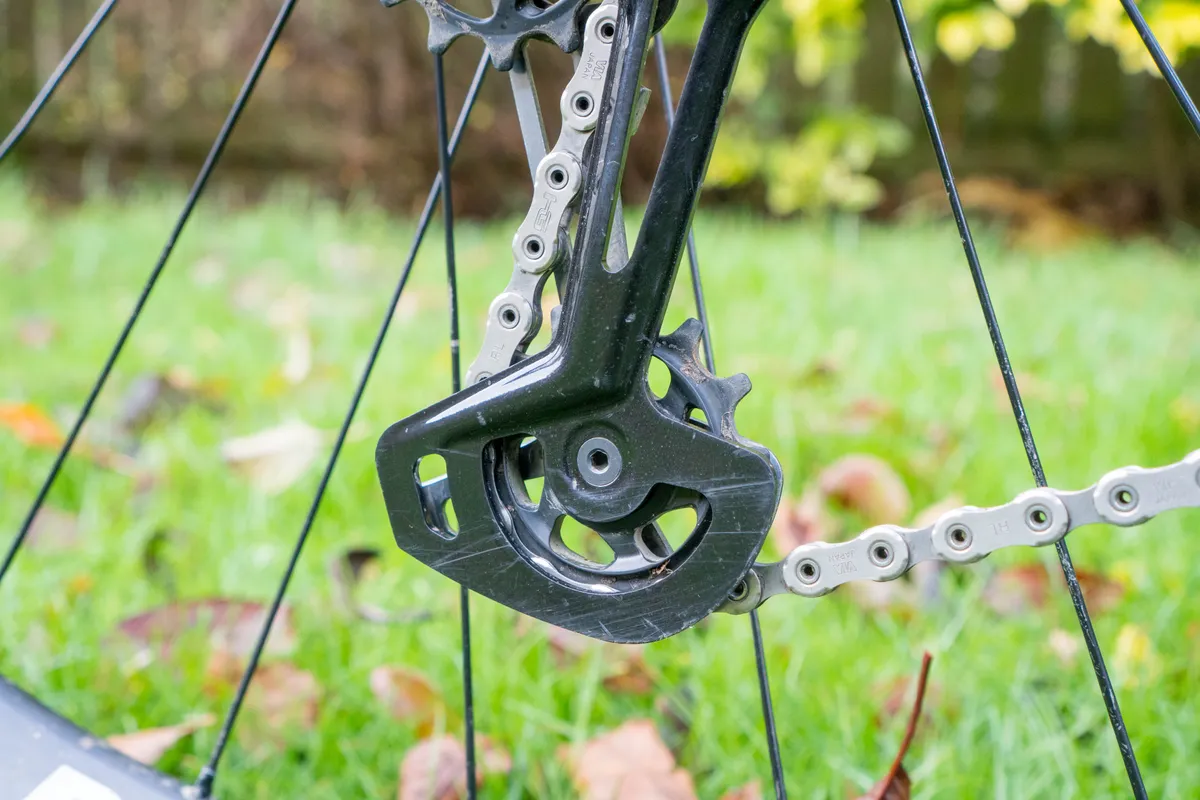
T-Type’s modular and rebuildable design makes it more repairable than Eagle AXS and Shimano derailleurs.
Some of Shimano’s derailleur cages are replaceable (as I discovered when I wrote off the cage on an XTR M9100 derailleur during testing) and replacement is relatively easy.
However, Shimano derailleur parallelograms cannot be dismantled or replaced, unlike T-Type.
Quantitatively stating whether the T-Type derailleur is stronger than Eagle AXS or Shimano’s versions isn't possible because I don’t have access to lab test equipment to do repeatable tests.
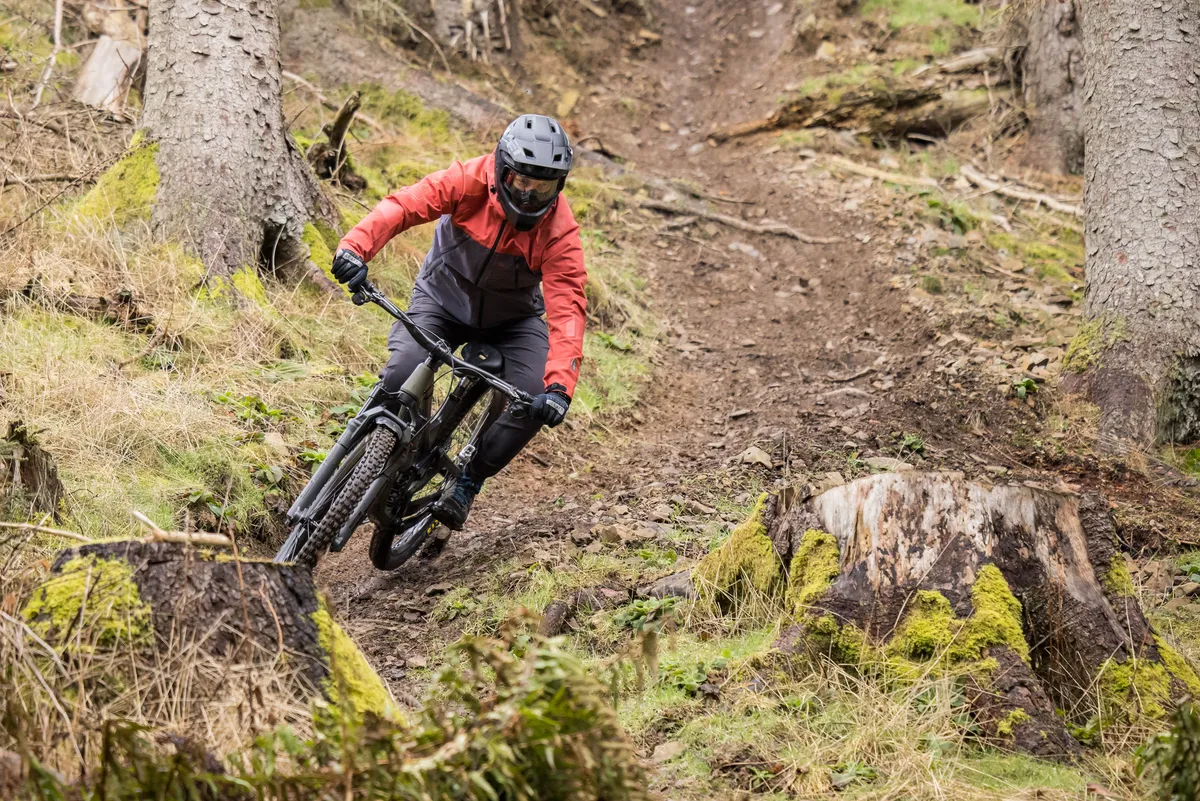
However, T-Type has proven to be very strong out on the trail, surviving plenty of knocks and bangs during the test period.
People concerned about the removal of the sacrificial derailleur hanger need not worry – the test bike’s frame is in as-new condition, and the derailleur remains straight and true, performing as it did on day one.
Addressing gear ratio complaints
Upping the tooth count of gears two and three of the T-Type cassette to 44t and 38t respectively increases the usability of those gears, and is an improvement on Eagle drivetrain cassettes.
T-Type ratios feel as considered as Shimano’s 10-51t cassettes, but with the bonus of an additional tooth on the lowest gear, increasing the block’s overall range.
Although Shimano’s cassette sprockets still have smaller jumps between each ratio compared to T-Type, the difference between the two brands is barely noticeable.
SRAM XX T-Type Eagle Transmission Powermeter AXS groupset bottom line
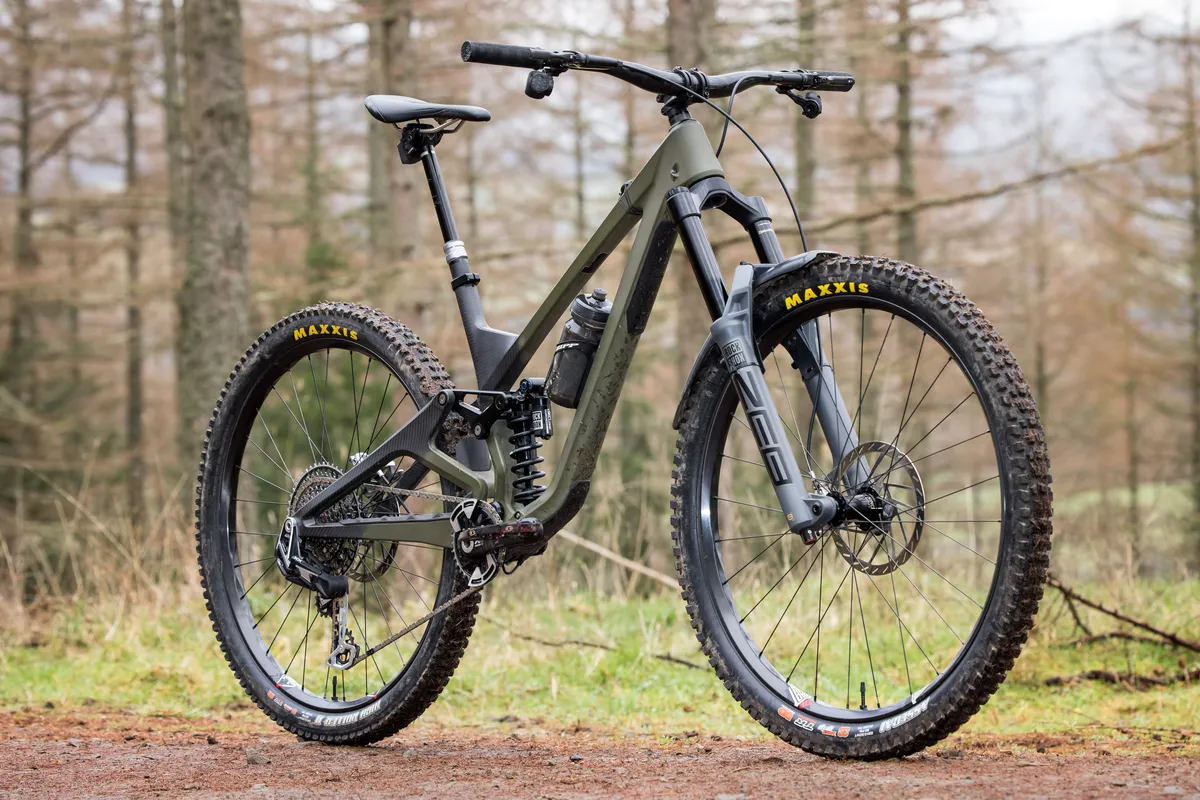
In short, it’s virtually impossible to fault the new SRAM T-Type Transmission.
Yes, accessing T-Type’s performance is expensive, and no backwards compatibility with Eagle drivetrains means a full-house upgrade is required. However, the level of performance on offer justifies the expense, and removing adjustment screws and simplifying setup is a fair trade-off for no backwards compatibility.
Without comparing it to current-generation systems, it’s still a giant leap forwards in terms of performance, design, functionality, reliability, durability, ease of rebuilding and simplicity of use and installation.
It is leagues ahead of SRAM’s Eagle drivetrains and Shimano’s current-generation 12-speed offerings.

Although SRAM hasn’t ripped up the drivetrain rule book – T-Type still uses a derailleur with a chain and cassette – the brand has refined and improved upon almost every detail, and addressed virtually all criticisms and complaints aimed at both Shimano and SRAM systems.
In doing so, it has recalibrated how riders should expect their drivetrains to work and feel, and how long they should last.
Is the performance worth the cost? Undeniably, yes.
Product
| Brand | sram |
| Price | 2750.00 EUR,2465.00 GBP,2299.00 USD |
| Weight | 1785.0000, GRAM () - 170mm DUB-PWR Powermeter cranks with 32t chainring with bash guards, rear derailleur with battery, 126 link chain with Power Lock, 10-52t cassette and Pod Controller Ultimate |
| br_whatWeTested | SRAM XX T-Type Eagle Transmission Powermeter AXS |
Features
| br_crankOptions | 1x |
| br_speed | 12 |
| Features | XX T-Type Eagle Transmission derailleur (with battery): 472g. T-Type Eagle Transmission AXS Pod Controller Ultimate (with Bridge Clamp): 55g. XX T-Type Eagle Transmission cassette: 384g. XX T-Type Eagle Transmission 126 link chain with Power Lock: 274g. XX T-Type Eagle Transmission 32t chainring with bash guards: 129g. XX T-Type Eagle Transmission 170mm cranks with DUB-PWR power meter: 471g |
| br_cassetteOptions | 10-52 |
| br_chainringOptions | 30t, 32t, 34t, 36t, 38t |
